Quality of the Environment in Japan 1992
(2) Surveillance on Effluent
In accordance with the Water Pollution Control Law, prefectural governors and the mayors of designated cities require reports from factories and business establishments, perform on-the-spot inspections there and issue orders for improvements, etc. The Environment Agency subsidizes the costs for that purpose and the costs needed for the development of water telemetric systems by local governments.
7-3-6 Purification Measures
(1) Measures for Purification of Rivers, Etc.
The following projects are carried out as projects for the develop-ment of the riparian environment (river purification projects):
Project cost: ¥10,210 million
(¥5,934 million under direct management, ¥4,276 million in subsidization) Contents of the projects
* Projects to Introduce Treated Water--Treated or clean water is routed from large rivers into low flow polluted rivers, to improve the flow (used for the Shin-arata River, Uchi River, etc.)
* Direct water treatment projects--Direct treatment of highly polluted river water in a REKIKAN contact and oxidation method and other methods (used for the Edo River, etc.)
* Sludge dredging projects--By dredging the sediments which contain much accumulated organic matter, attempts are made to reduce sources of pollution (used for Kasumigaura, Na-kanoumi, etc.)
(2) Improvements in Flow of Rivers, Etc.
In relation to water utilization and the conservation of the water quality, multipurpose dams and so forth are constructed in attempts to maintain and boost the normal functions of running water. At the same time, the routing of treated water is done in riparian flow adjustment projects.
Three hundred and twenty dam construction projects under the jurisdiction of the Ministry of Construction were completed as of fiscal 1990, and an additional 301. projects (including dam projects for mea-sures on the water environment) were conducted in fiscal 1991.
(3) Measures for Purification of Coastal Waters
The following projects were performed as measures for the purification of coastal waters:
(A) Subsidization of fishing ground cleanup projects (37 places) conducted by prefectures (B) Subsidization of rehabilitation projects (39 places), such as the dredging of coastal fishing grounds (C) Projects for the purification of sea regions, such as the removal of sludge (Fujisawa and two other seacoasts)
(4) Measures for Removal of Sediment Polluted with Mercury and PCB
On the pollution of sediment with mercury (after fiscal 1973), all measures were completed (as of the end of July 1991) for 42 waters which had been in excess of provisional removal standards and had required removal and other measures.
Of 78 waters which had required removal and other measures in relation to the pollution of sediment with PCB (after fiscal 1972), measures had yet to be completed for Sasebo and two other waters as of the end of July 1991.
7-3-7 Water Pollution Control Measures Associated with Agriculture, Forestry and Fisheries
(1) Measures Against Pollution of Agricultural Water
The following projects are under way as measures to conserve the quality of agricultural water:
* Understanding the actual quality of agricultural water, reservoir water and agricultural ground water
* Surveys on the actual quality, causes of pollution and so forth in large-scale agricultural reservoirs
* Surveys for the establishment of methods for improvements in the quality of agricultural water and agricultural waste water
* Agricultural hamlet waste water projects for the development of facilities to treat waste water discharged from agricultural ham-lets (670 districts)
* Projects associated with measures to cope with hazards to the water quality by urgently separating drainage channels and changing sources of water (1 district under direct management and 71 in subsidization)
(2) Fisheries-related Pollution Control Measures
The fisheries-related pollution Control measures as follows:
(A) The following types of surveys were broadly conducted:
* Surveys on the impacts and pollution of mercury, PCB, dioxin and other hazardous substances on fish and shellfish
* Surveys on the impacts produced on fisheries by the oxidation of lakes and reservoirs by acid rain, and studies on conservation measures
* Establishment of methods to predict the poisoning of shellfish
* Studies on the impacts produced on fishery resources by the massive discharge of water from power plants
* Studies on quantitative methods to monitor the purification func-tions of lagoons, shallow sea waters and so forth
(B) To prevent the damage caused by the oil pollution of fishing grounds and other types of fishery pollution, surveillance is made on fishing grounds and guidance given to fishermen by fishery pollution survey and guidance officials, and projects for the conservation of fishing grounds are subsidized. Also, the formulation of programs for the disposal of fishery-related waste, such as FRP and other ships of consumer and other organizations was subsidized.
(C) As measures against red tides, surveys were conducted on the generation of plankton (the Seto Inland Sea and so forth), and projects to watch the poisoning of shellfish by red tides were subsidized.
(3) Damage Relief Measures
In order to cope with the oil pollution accidents caused by unidentifiable persons, the relief projects of the Fund for Oil Pollution Damage to Fishing Grounds, a foundation, and other projects were subsidized. Part of the net premiums associated with the Special Clause for Red Tides of Aquaculture insurance.
7-4 Water Conservation Measures for Closed Waters
For bays, inland seas, lakes and reservoirs and other closed waters particularly with significant pollution sources in the hinterland, the rates of achieving environmental quality standards are lower than for other areas, because the loads of pollutants are significant and pollutants tend to accumulate. In addition, the inflow of nitrogen, phosphorus and other chemicals leads to the progress of so called eutrophication. The achievement rates of environmental quality stan-dards for closed waters remain low for Tokyo Bay and Ise Bay and also for Osaka Bay in the Seto Inland Sea. The rates are low particularly for lakes and reservoirs (Fig. 1-1-18 and Fig. 1-1-19 in Chapter 1, Part 1). A check of the generation of red tides indicates that there were 46 cases in Tokyo Bay, 111 cases in Ise Bay and 108 cases in the Seto Inland Sea, and in Tokyo Bay and other bays, the generation of blue tides is observed. There are now a few lakes and reservoirs where the genera-tion of blue-bloom and freshwater red tides is detected. Given this situation, there is the need to further strengthen measures for the conservation of the water quality of closed waters.
7-4-1 Promotion of Areawide Total Pollutant Load Controls
With the Water Pollution Control Law revision of 1978, areawide total water pollutant load controls were institutionalized for overall reduction in the loads of pollutants flowing into waters. This system is enforced for Tokyo Bay, Ise Bay and the Seto Inland Sea with COD taken up as a designated item.
Fig. 7-4-1 Generation Loads and Reduction Targets fore 3 Sea Areas with Areawide Total Pollutant Controls by Source
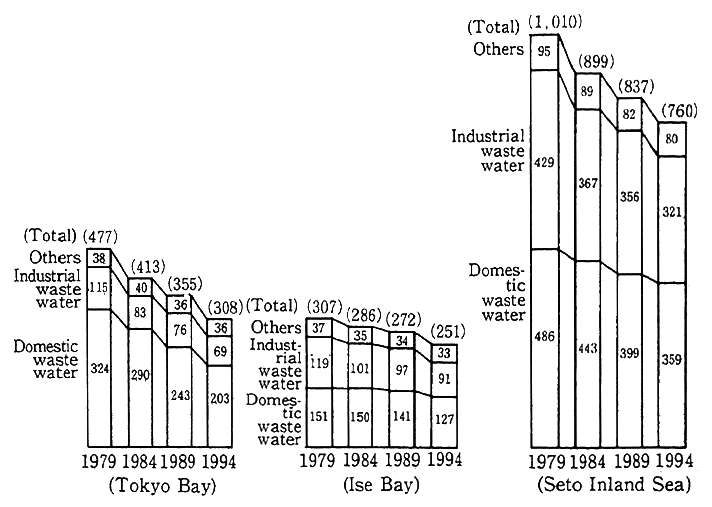
Remarks : Actual figures for FY 1979, 1984 and 1989 ; reduction target figures for FY 1994. (In tons/day)
The first series of areawide total pollutant load controls (with the target year set at 1984) and the second series of areawide total pollutant load controls (with the target year set at 1989) were carried out, but it was still necessary to improve the water quality of these waters. Therefore, the third series of areawide total pollutant load controls (with the target year set at 1994) is under way in accordance with the Basic Policy for Areawide Total Pollutant Load Controls (formulated in January 1991) and the Programs for Reductions in Areawide Total Pollutant load Controls (formulated in March 1991) is under way. The details of this series are shown in Fig. 7-4-1 The purpose is to reduce loads for the three waters by 10% (from fiscal 1989 ) by the target year.
As concrete measures, household effluent measures, such as the promotion of the development of sewage channels and the development of community plants, effluent facilities for agricultural hamlets, com-bined treatment and purification tanks-and so forth, industrial waste water measures, including the strengthening of areawide total pollutant load control standards, such as at factories, and various measures are being implemented in a comprehensive manner.
7-4-2 Measures for Conservation of Lake and Reservoir Environment
Lakes and reservoirs are closed waters, and they are significantly polluted. For this reason, the lakes and reservoirs for which the mainte-nance of environmental quality standards for water are required are designated in accordance with the Special Measures Law for the Conservation of Lake and Reservoir Water (enacted in 1984 and put into force in March 1985), and programs for the conservation of lake and reservoir water are formulated to promote measures. An outline of the lakes and reservoirs that have up to now been designated is given in Table 7-4-1. For Lake Biwa, Kasumigaura and three other lakes and reservoirs, controls were strengthened in October 1991 to implement measures for reductions in the discharge of nitrogen and phosphorus, and the second Lake and Reservoir Water Conservation program was formulated in March 1992.
Table 7-4-1 Outline of Designated Lakes and Reservoirs
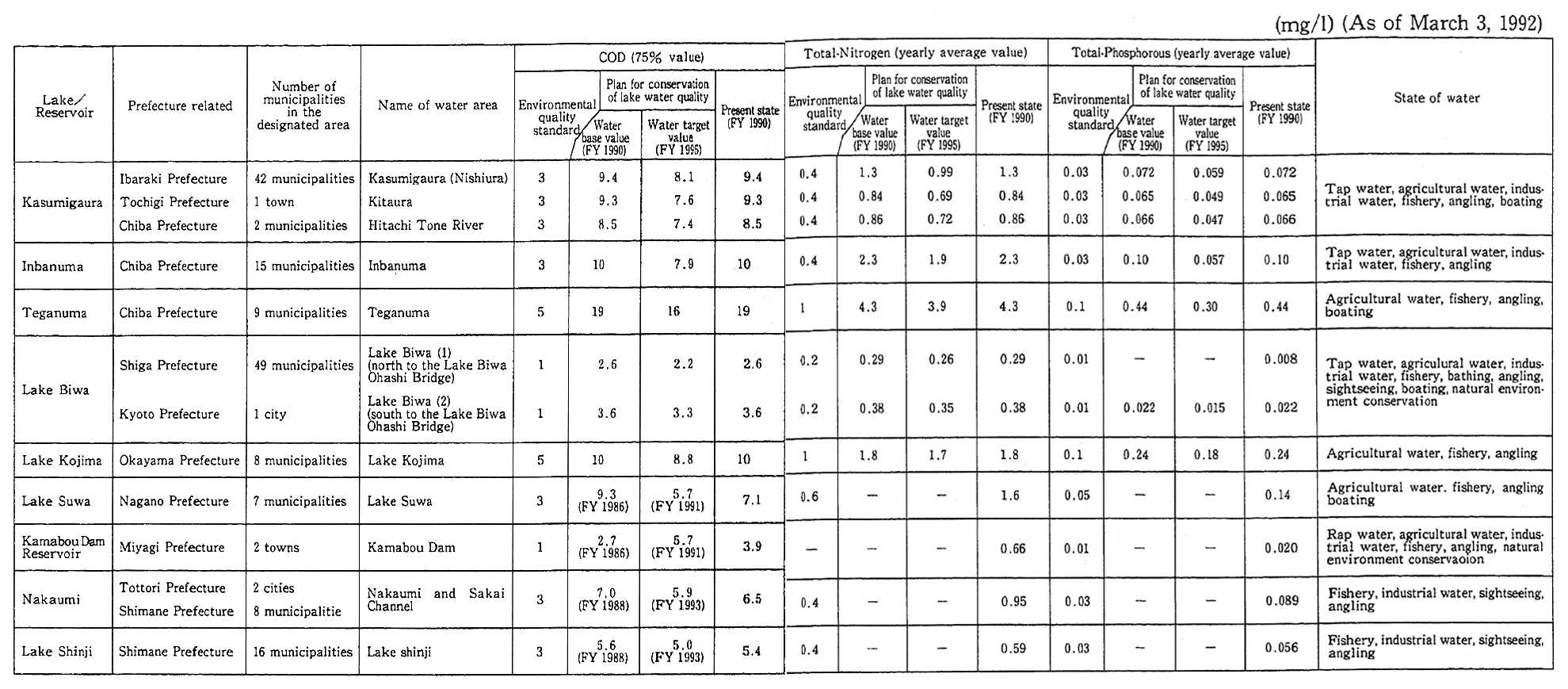
Remarks:1. Surveyed by the Environment Agency.
2. The maximum value in case there are more than one environment quality standfmd point.
7-4-3 Measures Against Eutrophication
In attempts to cope with eutrophication, which is a grave issue for lakes and reservoirs, the following measures are under way:
(A) Establishment of Standards
* In relation to lakes and reservoirs, notice was served on the environmental quality standards associated with nitrogen and phosphorus in 1982.
* Classifications are designated by the State and prefectural gov-ernments, and up to fiscal 1990, a total 48 waters (44 lakes and reservoirs), including Lake Biwa (2 water area), had been designated.
* Standards for ocean areas are under study by the Environment Agency.
(B) Strengthening of Controls
Controls on waste water have been under way on nitrogen and phosphorus since July 1985. Effluent controls are in place for phosphorus at 1,066 lakes and reservoirs and for nitrogen at 78 lakes and reservoirs. Also, pollutant load controls exist for nitrogen and phosphorus at Lake Biwa and four other designated lakes and reservoirs. As regards the Seto Inland Sea, guidance is being provided on reductions in the dis-charge of phosphorus and its compounds in accordance with the Special Measures Law for Conservation of the Seto Inland Sea Environment.
In regard to Tokyo Bay and Ise Bay, measures against eutro-phication have been implemented by related prefectures and cities since 1982. Concerning red tides in the Seto Inland Sea and blue tides in Tokyo Bay, the mechanisms for their occurrence have been surveyed.
7-4-4 Measures for Conservation of the Seto Inland Sea Environment
From old, the Seto Inland Sea had been blessed with scenic spots and had also been a treasure-house of fishery resources, but it has been rapidly polluted since the 1965-74 period. To cope with this development, environmental conservation measures are under way in accordance with the Special Measures Law for Conservation of the Seto Inland Sea Environment.
(1) Environmental Conditions of the Seto Inland Sea
The conditions under which the water of the Seto Inland Sea is placed is as follows:
Achievement of Environmental Quality Standards for COD 75% over all (fiscal 1990). Though considerable improvements are observed, the achievement rates are low for Osaka Bay and other sea regions.
Conditions of Red Tides Due to Seto Inland Sea's Eutrophication
(See Fig. 2-2-15, Chapter 2, Part 1)
Number of occurrences (1991):
107cases (confirmed by the Fishery Agency)
Damage:
a total 5 cases in June through October
Cases of Oil Pollution in Oceans
1972 874 cases
1991 179 cases (about 34% of the national total)
(2) Outline of Environmental Conservation Measures Taken Under the Special Measures Law for Conservation of Seto Inland Sea Environment
An outline of the measures taken for the environmental conserva-tion of the Seto Inland Sea is given below:
(A) Promotion of Prefectural Programs
Related prefectural governors formulate measures which are to be taken for conservation of the Seto Inland Sea's environment and carry out a wide variety of environmental conservation measures in accordance with prefectural programs.
(B) Permission for Installation of Specified Facilities
A licensing system is instituted for the installation of specified facilities. The number of cases in which licenses were given for the installation of facilities in fiscal 1990 was 526, and there were 485 cases in which the licenses were changed.
(C) Promotion of Areawide Total Water Pollutant Load Controls The third series of areawide total water pollutant load controls is under way with the target year set at 1994.
(D) Guidance on Reductions in Phosphorus and Its Compounds
Though guidance had been provided on reductions in phosphorus and its compounds since 1980, guidance continues to be provided on reductions in accordance with the third policy for reductions in phospho-rus and its compounds with the target year set at 1994.
(F) Conservation of Natural Seacoasts
For the conservation of natural seacoasts remaining in the related 10 prefectures, an ordinance on natural seacoast preservation areas, and other decrees were enacted, and by the end of December 1991, 88 areas had been designated as natural seacoast conservation areas.
(F) Consideration to Environmental Conservation in Reclamation
In issuing licenses and permits for land reclamation in public waters in the Seto Inland Sea, it is stipulated that related prefectural governors shall give full consideration to the special features of the Seto Inland Sea.
A check of the actual record of licenses and permits for land reclamation, there had been 3,432 cases with a total area of 8,414 hectares from the enactment of the Provisional Measures Law for Conservation of the Seto Inland Sea Environment. Over the period of one year from November 2, 1990, there were 147 cases with a total area of 174 hectares.
(G) Implementation of Environmental Conservation Projects
The following projects are under way:
a) In accordance with the seventh Five-year Sewerage Development Program, public sewer systems, water basin sewer systems and speci-fied public sewer systems for environmental conservation have been developed on a priority basis.
b) The development of waste oil disposal facilities where the waste oil of ships is disposed of was under way at 40 places in Seto Inland Sea ports (including 22 places in 16 ports where waste light oil is disposed of) as of October 1991.
c) The Maritime Safety Agency has designated the Seto Inland Sea as a priority sea region for monitoring and control. In fiscal 1991, the agency carried out three "Operations for the Cleaning of the Seto Inland Sea and the Uwa Sea"
d) Water quality surveys have been continuously conducted since 1972. Surveys have also been performed to better understand the mechanisms for the generation of red tides.
e) In fiscal 1991, too, the Environment Agency had the Seto Inland Sea Environment Conservation Association, a foundation, perform projects for the promotion of thought about environmental conserva-tion, such as study and lecture meetings.
7-5 Groundwater Pollution--Present State and Countermeasures
7-5-1 Present Situation of Ground Water Pollution
As a result of fact-finding surveys the Environment Agency performed in fiscal 1982 and 1983, pollution, such as bytrichloroethylene, was observed at many places. A check of the findings of general surveys conducted by local governments on groundwater over the period of five years from fiscal 1984 suggests that concentrations in excess of provi-sional water quality standards were detected in 2.7% with trichloroeyth-lene of about 27,000 wells and in 4.1% with tetrachloroethylene, observ-ing the pollution of groundwater at many places.
Table 7-5-1 Findings of Survey on General State of Groundwater Pollution
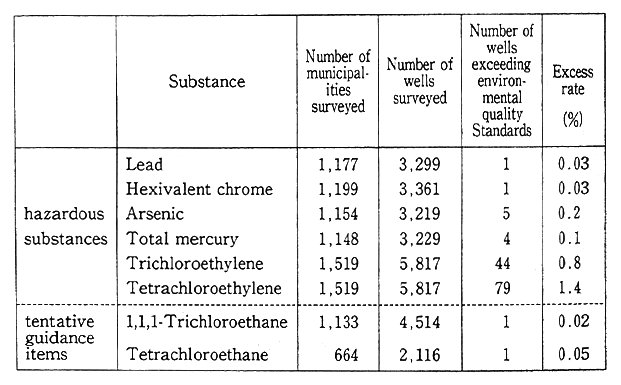
Under the Water Pollution Control Law, it was decided to start performing constant surveillance on groundwater in fiscal 1989, and the quality of ground waters is monitored. According to the findings of the monitoring of groundwater in fiscal 1990, general surveys were conduct-ed (groundwater surveys performed to grasp the quality of local water in general) in 1,554-municipalities. The rate of wells in excess of assessment standards was 0.03% for lead, 0.03% for hexivalent chrome, 0.2% for Arsenic, 0.1% for total mercury, 0.8% for trichloroethylene and 1.4% for tetrachloroethylene (Table 7-5-1).
The findings of surveys on areas around polluted wells(ground water surveys carried out to confirm the scope of pollution newly detected in general and other surveys) are outlined below:
Arsenic 2.2% (7/316)
Total mercury 7.6% (5/66)
Trichloroethylene 4.6% (130/2,838)
Tetrachloroethylene 8.9% (252/2,847)
The findings of regular monitoring surveys (surveys conducted as part of continuous monitoring) are as follows:
Lead 9.1% (1/288)
Hexivalent chrome 1.3% (4/301)
Arsenic 1.0% (3/303)
Trichioroethylene 10.9% (208/1,916)
Tetrachloroethylene 22.2% (429/1,936)
In all of those surveys, incidentally, there was no well in which other hazardous substances were in excess of environmental quality standards.
The Environment Agency also carries out fact-finding surveys on groundwater pollution for chemicals other that trichloroethylene and so forth. As a result, it was found in the survey for fiscal 1988 that the pollution of groundwater with dichloroethylene reached the point where there should be concern about it.
7-5-2 Measures Against Groundwater Pollution
Once polluted, groundwater is slow to recover, so that it is important to take preventive measures. From this point of view, attempts are being made to prevent groundwater pollution with a partial revision of the Water Pollution Control Law (with the revision coming into force on October 1, 1989). Implemented are such measures as a ban on the underground intrusion of water containing hazardous substances. The controls are outlined in Fig. 7-5-1.
Fig. 7-5-1 Systems of Controls, Etc., under the Revised Water Pollution Control Law (Related to Groundwater)
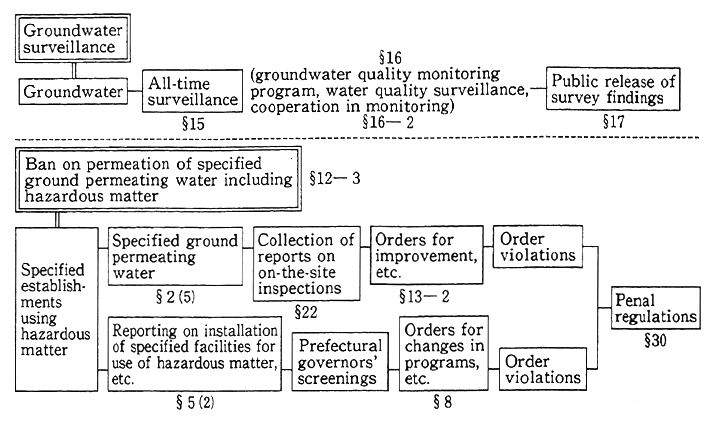
In addition, the Environment Agency established provisional environmental quality standards on carbon tetrachloride (April 1989) to give guidance on curbs on its emission. As regards dichloroethylene, the agency has called on prefectures and administrative ordinance-designated cities to strive to understand the actual conditions of ground-water pollution.
7-6 Marine Pollution--Present State and Countermeasures
7-6-1 Present State of Marine Pollution
(1) Ports and Harbors and Surrounding Seas
Though quality of waters and sediments are on the way toward improvements, there remain many waters, which are polluted by effluent from factories, business establishments and households. In ports and harbors along Tokyo Bay, Ise Bay, the Seto Inland Sea and so forth and their surrounding waters, the generation of red tides and so on is continuing.
(2) Seas Around Japan
The Environment Agency carries out a survey on marine pollu-tion in the seas around Japan--a survey which is performed along the monitoring line (linking the coast to designated sea-Sea Area A, where dumping of solidified sludge and other pollutants containing heavy metals and others specified under the Law Relating to the Prevention of Marine Pollution and Maritime Disasters are allowed). In addition to general marine observation, the agency also surveys sea water, the concentration of heavy metals in the sediment and so forth.
The Maritime Safety Agency also carries out marine pollution surveys, including oil, PCB, heavy metals and other substances in the sea water and sea bed of the seas around Japan, Sea Area A and major ports and harbors. The findings show that there was no progress in reducing marine pollution.
Surveys on the floating and drifting ashore of waste oil ball are under way. According to the findings of the 1991 survey, the floating waste oil was on the increase in sea regions along the coasts of the Japan Sea and oil drifting-ashore was on the decrease in sea regions along the Pacific coasts.
According to an observation conducted on sea surface floatage from January to December 1991, 65% of surface floatage are styrofoam and other petrochemical products.
Confirmed by the Maritime Safety Agency, the number of cases in which marine pollution was occurred in the seas around Japan is given in Table 7-6-1. A 1991 check of oil pollution by source indicates that the majority (419 cases) was caused by ships. They include 161 due to careless handling and 104 due to deliberate act. Of the cases of non-oil pollution, there were 209 cases which originated on land. Virtually every one of them was caused by deliberate acts.
The Meteorological Agency performs marine background pollu-tion observation in the seas around Japan and in the Western Pacific. The findings are as follows:
* Mercury and cadmium --The same levels of concentrations as in other areas
* Waste oil balls --Remains low levels since 1982
*Pollutants afloat on the sea surface --The concentrations were leveling off on the open sea but high on the sea along the southern coast of Honshu Island.
* Oil slicks --Detected several times on the seas around Japan in 1990 and 1991
The Fishery Agency has been surveying the distribution of float-ing pollutants on the entire Pacific. In the 1990 observation, plastics accounted for 55.4% of all detected floating pollutants. The agency concluded that plastics were very densely distributed over the Central Pacific, the seas around Japan and so forth.
Table 7-6-1 Trends in Number of Ascertained Cases of Generation by Polluted Sea Area
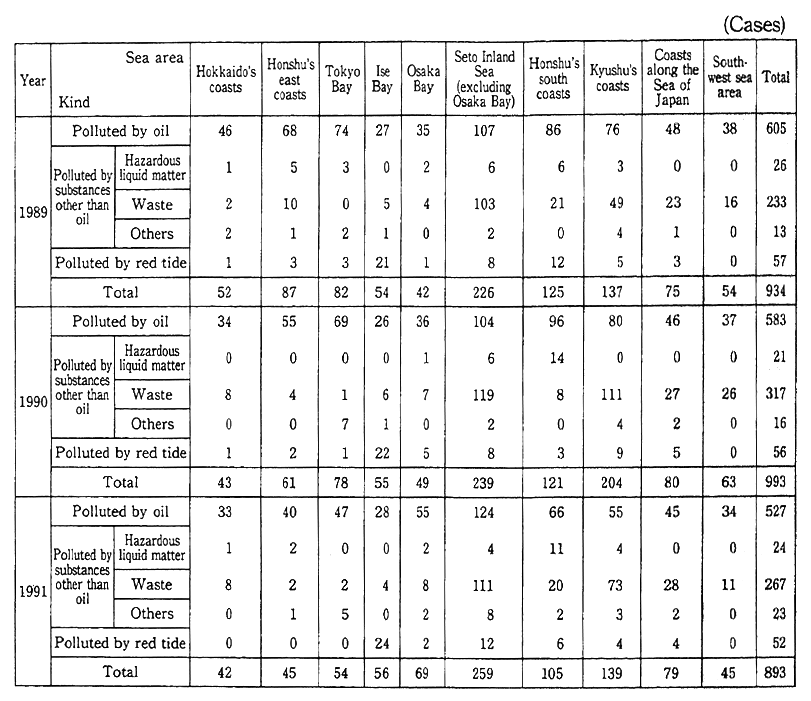
Remarks: Surveyed by the Maritime Safety Agency. In the category of "polluted by substances other than oil," "others" represent industrial waste water, etc.
7-6-2 Marine Pollution Prevention Measures
(1) Prevention Measures
The following measures are being taken to prevent marine pollution:
a. Controls on Ships
* Controls on the discharge and incineration of oil, hazardous liquid matter and wastes
* Inspections for the assurance of compliance with technical stan-dards on the structure and facilities of ships
* Issue of certificates for marine pollution prevention
b. Rating of Liquid Matter Not Yet Rated
The Environment Agency assesses liquid substances which has yet to be assessed. As of the end of December 1991, 121 substances were assessed and notice was served on them.
c. Guidance on Marine Pollution Prevention
Lecture meetings on marine pollution prevention carried out by the Ministry of Transport and the Maritime Safety and the Week for the Promotion of Marine Pollution Prevention set by the Maritime Safety Agency
d. Development of Waste Oil Treatment Facilities
Improvement of public waste oil treatment facilities for which treatment of waste oil from ships is under way. The outline is as follows:
Waste oil treatment facilities 133 places at 81 ports
Treatment of waste light oil 49 places at 35 ports
(2) Development of Systems for Prevention and Removal of Waste Oil
In order to cope with oil releases and other pollutants, the Maritime Safety Agency carries out the following measures:
* Maintenance of a system of immediate ship response at any time and the development of preventive and removal equipment
* Guidance and development of the Maritime Disaster Prevention Center, which is the core institution in the non-governmental sector for prevention of maritime disasters (removal of emitted oil in eight cases in 1991)
* Guidance and development of the Council on Measures to Cope with Disasters Caused by Released Oil
* Training by the governmental and non-governmental sectors to cope with large scale oil spill accidents
(3) Measures for Purification of Ports and Harbors
Measures for the prevention of pollution at ports and harbors, such as the dredging of organic sludge, were carried out at Tokyo and 13 other ports. Regional seas environment creation projects were on the Seto Inland Sea and another sea region and at three ports.
(4) Research and Development of Technology for Marine Pollution Prevention
A wide variety of techniques for the prevention of marine pollu-tion are being researched and developed, including research and develop-ment by the Ministry of Transport for the prevention of oil spills.
7-6-3 Monitoring and Control of Marine Pollution
(1) Present Situation of Monitoring and Control
The Maritime Safety Agency controls marine pollution in the seas around Japan. In its surveillance and control, priority is given to Tokyo Bay, Ise Bay, the Seto Inland Sea and other regional seas which have tanker routes where the probability is high of pollution being generated.
(2) Referral of Marine Pollution Cases
The cases of violations of the laws and ordinances related to marine pollution are indicated in Table 7-6-2. The number of cases in which oil, toxic liquid substances and waste were discharged stood at 1, 259, accounting for 93% of the total number.
Table 7-6-2 Number of Cases Referred to Prosecution for Violation of Maritime Environmental Pollution-Related Laws and Ordinance
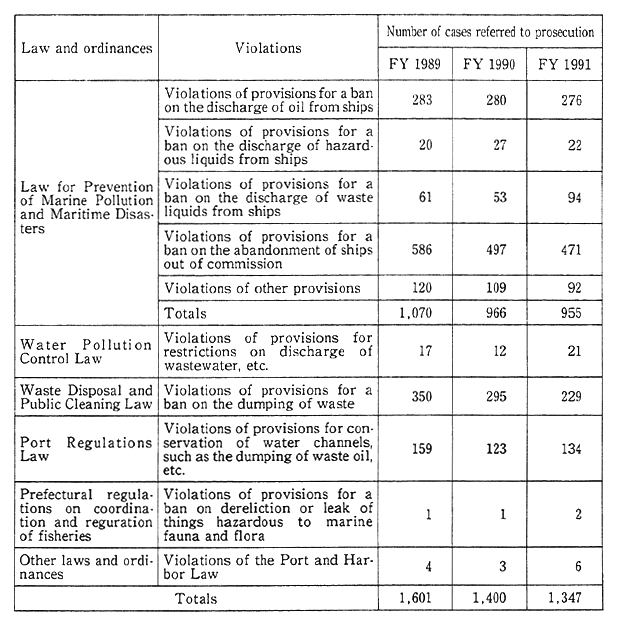
Source : Marine Safety Agency's survey
7-6-4 Compensation for Damage Caused by Oil Pollution
In order to provide relief for sufferers, as the damage caused by the oil accidents involving is so enormous in amount, the International Convention on Civil Liabilities for Damage by Oil Pollution and the International Convention for Establishment of an International Fund for Compensation of Damage Caused by Oil Pollution have been estab-lished. In addition, the Law for the Reparation and Compensation of Damage by Oil Pollution was enacted, under which (1) ship owners are assigned with no-fault liability for compensation, (2) limits to specially responsible amounts are set, (3) tankers carrying more than 2,000 tons of oil are obligated to carry special responsibility insurance contracts, and (4) sufferers may be secured by the international fund, should they be unable to have access to full compensation under the aforementioned compensation and reparation system.
In 1984, a protocol for revision of the aforementioned two interna-tional conventions was adopted, and Japan's response to it is under study. When it comes to the damage caused by oil pollution for which the responsible persons cannot be identified, the relief measures to affected fishermen are subsidized by the Fishing Ground Oil Pollution Damage Relief Fund, a foundation. Relief was made in a total of 33 cases with the outlay of ¥138,420,000.
Chapter8. Other Pollution--Present State and Measures
8-1 Wastes Disposal-Present State and Counter Measures
8-1-1 Outline of Disposal of Wastes
(1) Disposal of General Waste
General wastes are treated according to disposal programs for-mulated by municipalities. The means of disposal of human wastes is shown in Table 8-1-1.
The installation of septic tanks is indicated numerically in Fig. 8-1-1, and about one-fourth of the people are contributing to the dissemi-nation of flush-toilet systems.
Fig. 8-1-1 Number of Human Waste Purification Tanks Installed
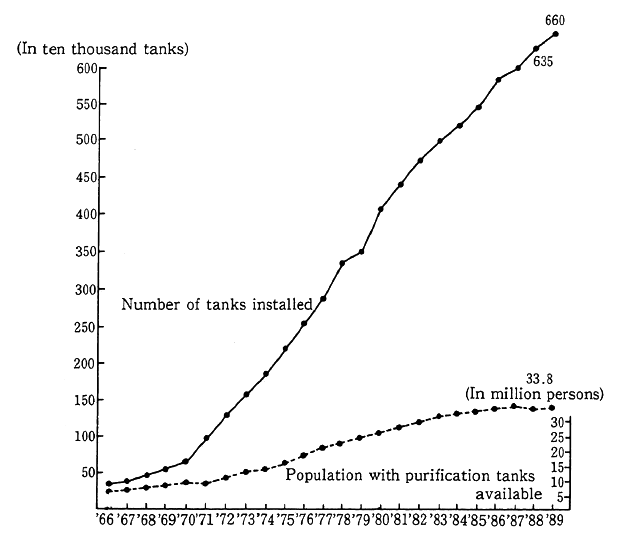
Table 8-1-1 Treatment of Human Waste
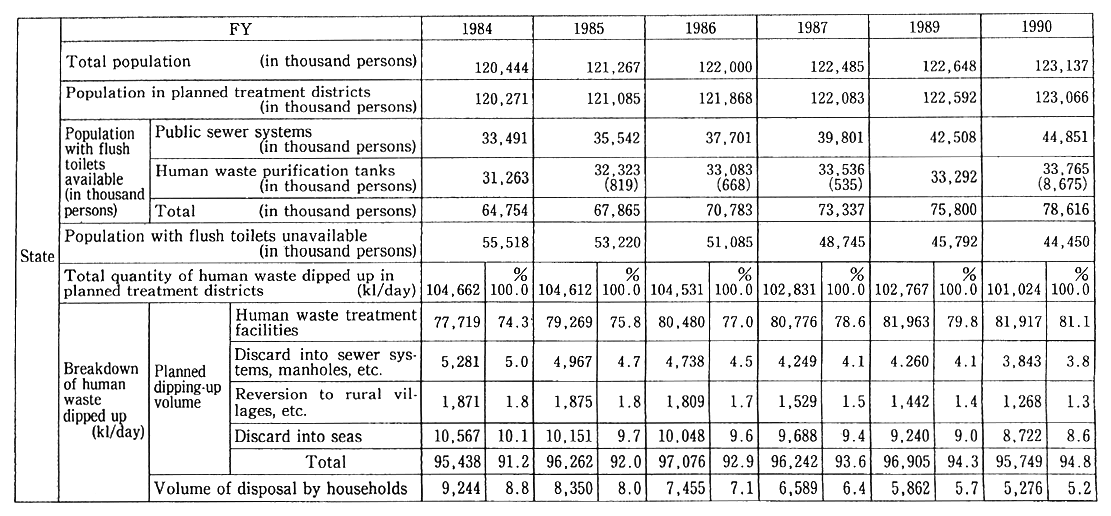
Remarks:1. Surveyed by the Ministry of Health and Welfare.
2. Total volume of human waste dipped up=volume of human waste dipped up + volume of sludge in humanwaste purification tanks.
3. The figures in parentheses in the row for the population with human waste purification tanks available represent the population for whom community plants are available.
4. As fractions are cut away, the total figures do not coincide with the breakdown figures.
5. The total population includes the population of foreign residents in some municipalities.
Table 8-1-2 Treatment of Trash
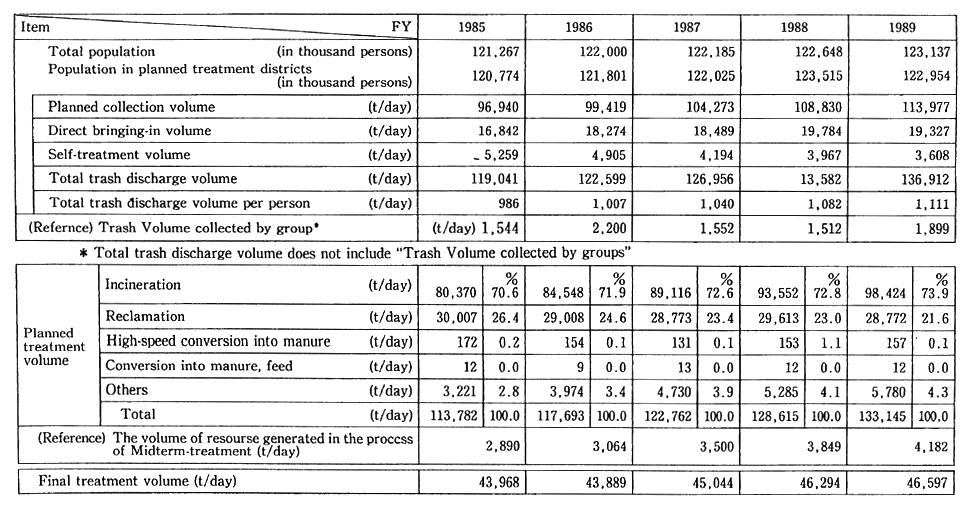
(Note) (3)=(2)/(1)
* Trash Volume collected by groups is equal to the volume collected by PTA (Parents and Teachers Association) and local community and others under the direction o the public.
* The volume of resourse generated in the process of Midterm-disposal consists of Iron, Aluminum which is recycled from the valuable trash
* As fractions are cut away, the total figures do not coincide with the breakdown figures.
* The total pollution includes the population of foreign residents in some municipalities
The methods of general wastes disposal are indicated in Table 8-1-2. The total discharge of wastes in fiscal 1989 registered a sharp rise of 3.8% from the previous fiscal year.
(2) Disposal of Industrial Wastes
The discharge of industrial wastes is shown in Table 8-1-3. The installation of industrial waste disposal facilities is shown in Table 8-1-3. The installation of industrial waste disposal facilities is indicated in Table 8-1-4.
Table 8-1-3 Discharge of Industrial Waste (National)
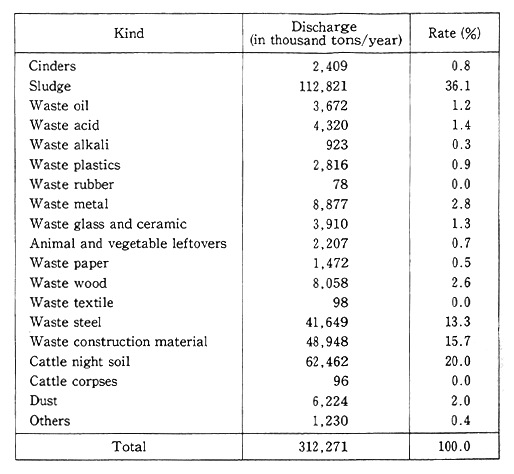
Remarks: Surveyed by the Ministry of Health and Welfare
Industrial wastes are treated at the responsibility of entrepre-neurs, in principle. As the role played by industrial waste disposal agents however, had become important in recent years, the number of cases in which licenses were awarded to industrial wastes disposal agents stood at 67,848 as of April 1990.
Table 8-1-4 Installation of Industrial Waste Treatment Facilities
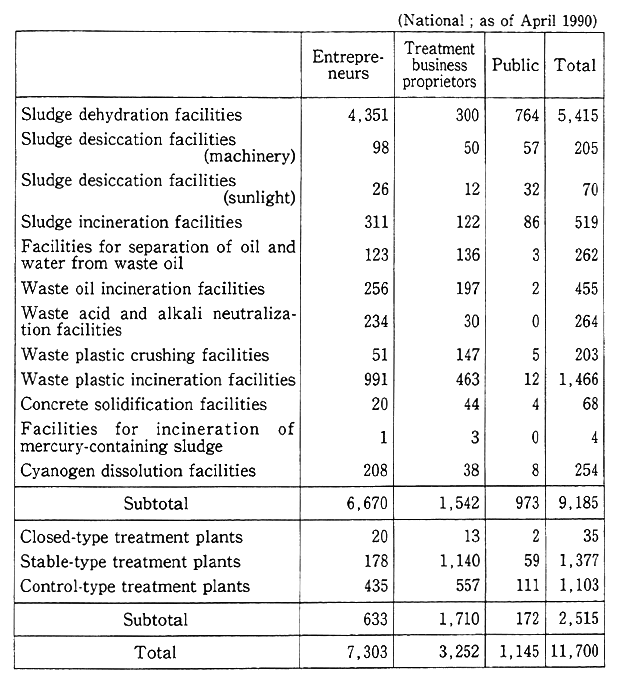
Remarks:1. Surveyed by the Ministry of Health and Welfare.
2. The facilities are those on which reports are filed under Article 15, Paragraph 1, of the Waste Treatment Law.
3. The final disposal plants where industrial and general wastes are put together for reclamation are included in the control-type treatment facilities.
4. "Public," referred to in the table, represents bodies corporate which are tied in with municipalities' tap water and sewer systems and industrial water projects.
8-1-2 Waste Disposal Measures
(1) Revision of Law Concerning Waste Disposal and Public Cleaning
Given a rise in the wastes generation and a diversification of waste type, the difficulty of securing waste disposal facilities and illegit-imate disposal, such as the illegal throwaway of wastes, have become a serious social issue. Given this situation, the Law for the Partial Revision of the Waste Disposal and Public Cleaning Law and the Law for Special Measures for the Improvement and Construction of Waste Treatment Facilities were enacted.
This law is so formulated that measures are implemented with primary attention focused on:
(A) Promotion of measures to reduce waste volume and recycle it
(B) Assurance of the proper disposal of wastes
(C) Development of disposal plants
(2) Formulation of Seventh Waste Disposal Facility Development Program
In November 1991, the Seventh Waste Disposal Facility Develop-ment Program was formulated to promote the development of waste disposal facilities with a gross project outlay of ¥2,830 billion over a project period of five years from fiscal 1991.
(3) General Waste Measures
In fiscal 1991, disposal facilities were developed, including waste disposal facilities, human waste disposal facilities, facilities at re-claimed tracts of land and so forth with a total of ¥71 billion in subsidies from the General Account and a total of ¥17 billion in loans from the Special Account for Industrial Investments. The Ministry of Health and Welfare is replenishing a project to reduce the discharge of wastes.
(4) Combined Treatment septic Tanks
Hopes are pinned on combined treatment septic tanks as an effective means to cope with household waste water. The combined treatment septic tank development project is outline below:
National Treasury subsidies in FY 1991
¥5 billion
Number of project-implementing municipalities
769 municipalities in fiscal 1990
about 1,120 municipalities in fiscal 1991
Earlier, the combined treatment septic tank development project had been designed for areas other than those for which sewage projects had been planned. Beginning fiscal 1991, subsidization projects have been under way even in the areas for which sewage projects are planned, including those designated under the Special Measures Law for Conser-vation of the Water Quality of Lakes and Reservoirs, and the priority areas designated for measures to cope with household waste water effluents under the Water Pollution Control Law, in the case that the development of sewage systems is not expected in seven years.
Also, systematic development of community waste treatment plants and combined treatment septic tanks is being done under the household effluent waste water treatment programs worked out by municipalities.
(5) Industrial Waste Counter Measures
As regards industrial wastes, illegal disposal and other improper means of disposal are still occur. The discharge volume is on the increase as are the types of wastes. The following measures are being taken to cope with industrial wastes:
(A) Dissemination of, the "Asbestos Waste Disposal Guideline", "Medical Care Waste Disposal Guideline" and "Construction Industry Waste Disposal Guideline", and formulation of the "Fishery Waste Disposal Guideline"
(B) A system of manifests was introduced in April 1990 to understand and regulate, under administrative guidance, the system in which indus-trial wastes are treated.
Incidentally, the situation of administrative disposition on illegal industrial waste treatment in fiscal 1989 is as follows:
On-the-spot inspections 35,339 cases
Reports collected 12,350 cases
Permits canceled or temporarily suspended 61 cases
Counter Measures or improvements ordered 10 cases
Concerning the recycling of wastes, the Ministry of International Trade and Industry subsidizes tests, research, surveys and recycling projects. In regard to construction industry's wastes, the Ministry of Construction formulated the immediate Policy for the Promotion of Measures for Coping with the Construction Industry's Wastes in March 1991, under which measures have been implemented. Incidentally, how wastes from the manufacturing industry are disposed of is shown in Table 8-1-5.
Table 8-1-5 Recycling of Industrial Waste (FY 1987)
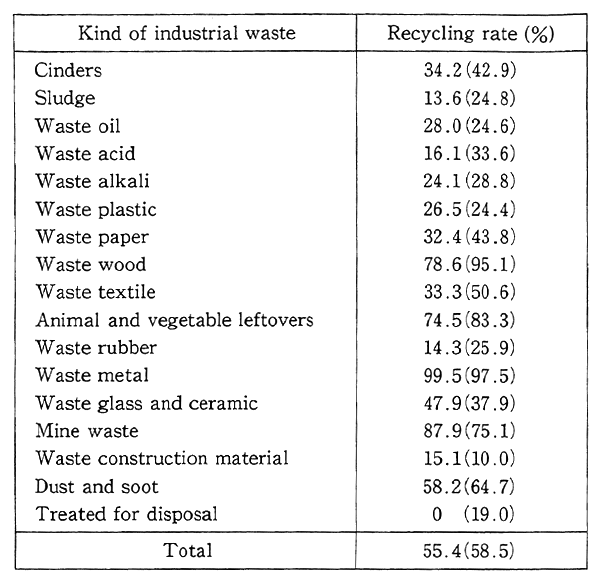
Remarks: Surveyed by the Ministry of International Trade and Industry. The figures in parentheses are those for FY 1998.
(6) Enactment of the "Law for the Promotion of Utilization of Recyclable Resources"
In order to effectively utilize finite resources and contribute to curbs on the wastes generation and to environmental conservation, the Law for the Promotion of the Utilization of Recyclable Resources was enacted in April 1991, effective in October 1991. In order to increase the utilization of recyclable resources, the law stipulates a "basic policy" of systematically and comprehensively promoting the use of recyclable resources, and it is stipulated in the law that competent ministers shall develop judgment criteria for private industry, provide guidance and counsel according to those criteria. If necessary, they may make recom-mendations and take other measures in promoting the utilization of recycled resources by specified businesses. Included as specified indus-tries are paper manufacturing, glass container manufacturing and construction industries. Additionally they may devise the structures, materials for Category I products (motor vehicles, air conditioning systems, televisions, electric washing machines and electric refrigera-tors), prepare easy-to-identify labels for Category II (aluminum and steel drink cans) and promote the utilization of designated by-products (iron and steel slugs, coal ash, earth and sand, lumps of cement, lumps of asphalt concrete and wood) as recycled materials.
(7) Development of Cross-Jurisdictional Disposal Facilities (I.e., large scale)
In order to respond to calls for the establishment of cross-jurisdictional disposal facilities in major cities, the Ministries of Health and Welfare, and Transport are promoting an cross-jurisdictional waste reclamation and disposal plant program (known as the Phoenix Plan). In the Osaka Bay area, the Osaka Bay Cross-Jurisdictional Littoral Envi-ronment Development Center continued to carry out the construction of cross-jurisdictional disposal plants, accepted wastes and disposed of them by means of reclamation.
In the Tokyo Bay area, surveys were conducted to study on Cross-Jurisdictional Disposal and identify concrete measures based on the "Tokyo Bay Phoenix Plan".
The Ministry of Health and Welfare carries out basic surveys in the Chubu area and the Kita-Kyushu area.
(8) Others
In addition, the following measures are implemented:
(A) Problems About Final Shutdown and Removal of Disposal Plants The Environment Agency and the Ministry of Health and Wel-fare co-provided guidance on the basic administration of shutdown and removal for waste disposal plants in accordance with notices served in their names (November 1989). The Environment Agency surveyed management of these sites.
(B) Development of Coastal Protection Measures for Waste Recla-
mation
In fiscal 1991, the Ministry of Transport subsidized the develop-ment of coastal protection measures works for land reclamation using wastes at a cost of about ¥25,500 million (including about ¥6.7 billion from the National Treasury) for 27 ports and one bay.
(C) Response to Basel Convention
The Environment Agency has surveyed the hazardous wastes defined in the "Basel Convention on the Control of Transboundary Movements of Hazardous Wastes and Their Disposal".
8-2 Ground Subsidence--Present State and Counter Measures
8-2-1 Present State of Ground Subsidence
Annual changes in ground subsidence in typical areas are shown in Fig. 8-2-1 Purposes for the withdrawal of ground water, which constitutes the primary cause of land subsidence, are not confined just for industry and construction but are diversified, such as for drinking water systems, agriculture, aquaculture and snow melting. The present state of ground subsidence by region is shown in Fig. 8-2-2, covering 61 districts in 36 prefectures.
The characteristics of ground subsidence in Japan in recent years are as follows:
(1) A check of the nationwide state of ground subsidence in fiscal 1990 by area indicates that recently there are trends of a decrease but that ground subsidence was greater in fiscal 1990 than in fiscal 1989 in terms of area.
By district, considerable degrees of ground subsidence were observed in the north of the Kanto Plains as in the past, and significant degrees of ground subsidence were observed in the Chikugo-Saga Plains. The areas where great degrees of ground subsidence (in excess of 4 centimeters a year) were observed in fiscal 1990 are as follows:
Kanto Plains in Tochigi Prefecture 6.7 cm
Center and Shonan in Kanagawa Prefecture 5.2
Chikugo-Saga Plains in Saga Prefecture 4.5
Kanto Plains in Saitama Prefecture 4.4
Kanto Plains in Ibaraki Prefecture 4.3
Fig. 8-2-2 Area of Ground Subsidences Across the Nation (Tendency of Each Year)
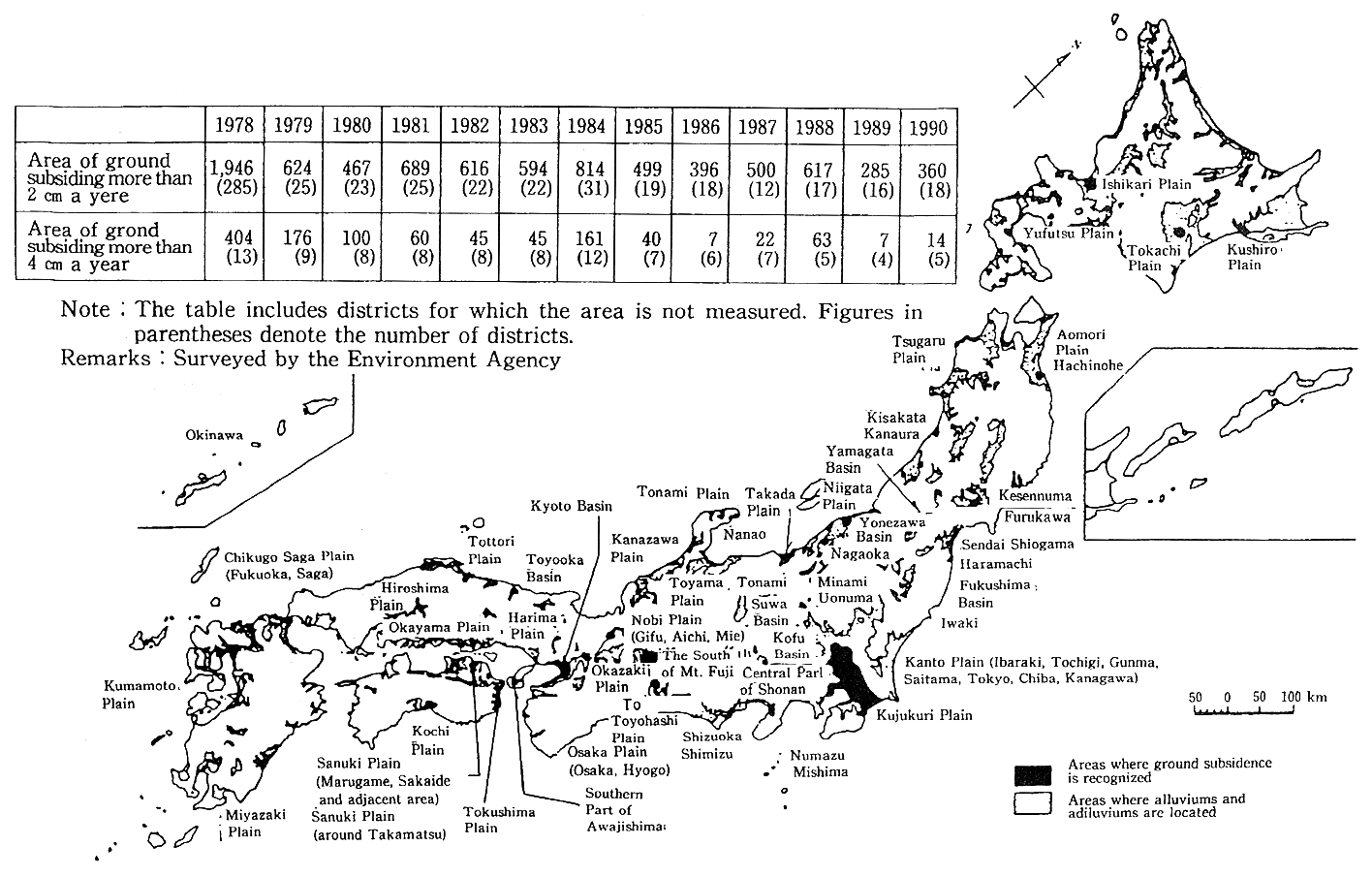
Fig. 8-2-1 Secular Changes in Ground Subsidence in Typical Areas
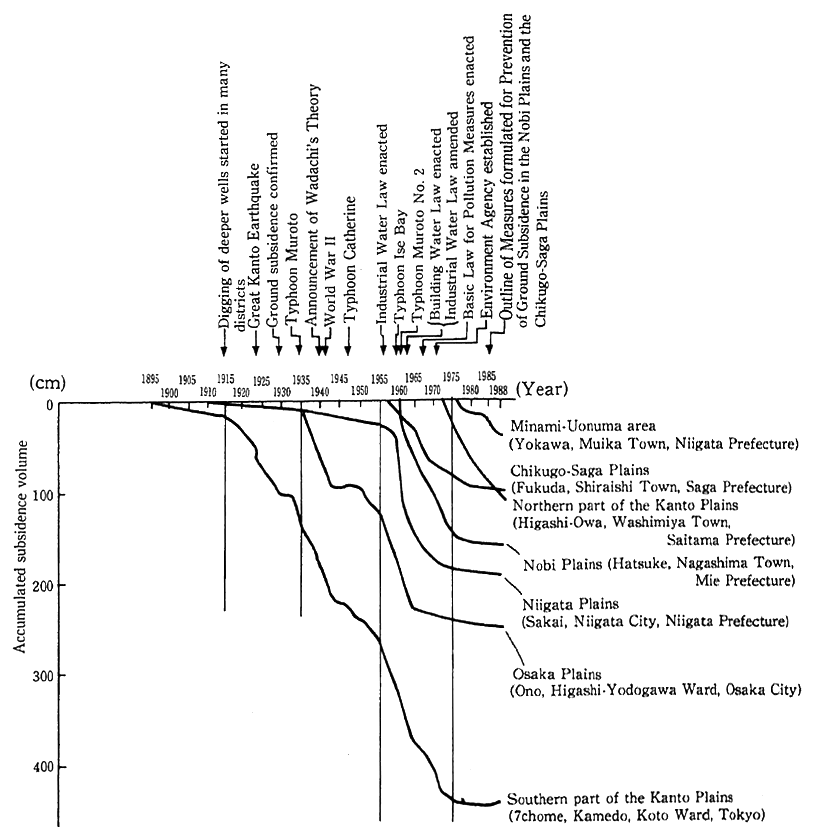
(2) In Tokyo's wards, Osaka City, Nagoya City and other urbanized areas where there were significant degrees of ground subsidence, ground subsidence has slowed down or virtually come to a stop. In other areas, there are signs of an improvement in a long-term perspective, but ground subsidence continues in some of them as in the past.
(3) Due to many years of ground subsidence, structures,irrigation facilities, port and harbor facilities, farmland and agricultural facilities have been damaged in many districts, and in some zero-meter-high areas, there is the danger that some severe disasters, such as floods, high tides and tsunami, might occur.
8-2-2 Ground Subsidence Measures
The following Counter measures against ground subsidence are being taken.
(1) Controls on Groundwater Withdrawal
* Ten prefectures are designated under the Industrial Water Law and some districts of four prefectures under the Law Concerning Controls on the Withdrawal of Groundwater for Building Pur-poses to control the withdrawal of groundwater.
* In addition, controls under local government decrees. Voluntary controls are exercised on the withdrawal of groundwater for industrial purposes and administrative guidance are made to reduce the withdrawal of groundwater.
(2) Surveys
Local governments were subsidized for the costs required for geological surveys on fluctuations in the ground height and groundwater level which are necessary for the monitoring of areas where the with-drawal of groundwater is controlled. In addition, the measurement of water levels designed to understand the actual state of ground subsi-dence and surveys on the pumping of groundwater, were conducted.
(3) Substitute Water Measures
In order to reduce the withdrawal of groundwater, projects for the securing of substitute water and those for the supply of substitute water were carried out. In areas where measures are required particu-larly for industrial water, projects for industrial water systems are promoted with subsidies granted from the National Treasury.
(4) Damage Rehabilitation Projects
In areas where significant ground subsidence have occurred, rehabilitation projects, measures against high tides, the development of facilities for the removal of closed water, development of facilities for seacoasts conservation of land improvement projects are conducted.
(5) Comprehensive Measures
In order to carry out comprehensive measures, outlines of mea-sures for the prevention of ground subsidence,was formulated in April 1985 for the Nobi Plains and for the Chikugo-Saga Plains. In addition, an outline of measures has been formulated and put into action for the northern Kanto Plains.
8-3 Soil Pollution--Present State and Counter Measures
8-3-1 Present State of Soil Pollution
In areas where there is a risk of pollution, elaborate surveys on the state of pollution of farmland soil are under way, and in fiscal 1990, a survey on cadmium was conducted in 11 areas covering a total area of 718 hectares and a survey on copper and arsenic in one area for each covering an area of 70 hectares. As a result, there was no area where designation for areas requiring measures (areas where values in excess of the standard values) were needed. The aggregate total of areas where values were in excess of the standard values was 128 covering an aggregate area of 7,050 hectares.
On the other hand, there are cases in conjunction with the redevel-opment of urbanized areas in recent years where toxic substances has penetrated the soil due to accidents, such as the breakdown and damage of facilities at factories, and to illegal waste disposal.
8-3-2 Measures Against Soil Pollution
(1) Establishment of Environmental Quality Standards
The Environmental Quality Standards for Soil were formulated in accordance with Article 9 of the Basic Law for Environmental Pollution Control on August 23, 1991, as the standards to protect human health and conserve the living environment. The standards are basically applicable to all kinds of soil, including that for farmland, and they are defined as targets for administration for the soil conservation.
In formulating the standards, among various functions of soil, we focus on conserving two main function; one is water purification and groundwater cultivation; another producing food. From perspective of first function, concentrations of pollutants leaching out of the soil should meet water quality standards for nine substances designated as health items. From the perspective of conserving the functions of soil to produce food, agricultural areas should not be designated as special areas for countermeasures under the Agricultural Land Soil Pollution Prevention Law.
Those standards are expected to be used for judgment over whether the soil is polluted and over which improvement measures associated with soil pollution should be taken.
(2) Agricultural Land Pollution Prevention Measures
Within all areas where concentrations in excess of environmental quality standards are detected, those specially designated areas for countermeasures are made subjects for the implementation of special land improvement projects for the prevention and elimination of pollu-tion, (including soil removal, the import of soil from other places to be mixed in the soil). The execution of such projects is shown in Table 8-3-1. In cadmium-polluted areas, incidentally, measures are taken to prevent the production of contaminated rice as a provisional measure which will remain in force until the projects are completed.
(3) Urbanized Area Soil Pollution Prevention Measures
As regards the soil of urbanized areas, surveys are conducted on compliance with environmental quality standards by taking advantage of opportunities for land transformation, when there are clear or pos-sible signs of soil pollution. It is made a practice to encourage entrepre-neurs to take measures necessary for the prompt achievement of envi-ronmental quality standards, when it is clear that the soil is actually polluted. For this purpose, the Japan Environment Corporation carries out loan projects for the costs required for clean up measures.
When it comes to soil and groundwater pollution by trichloroeth-ylene and other chemicals, which is an issue across the nation, surveys were conducted to establish measures to cope with it in an effective and economical way.
Table 8-3-1 Progress of Measures Against Farmland Soil Pollution
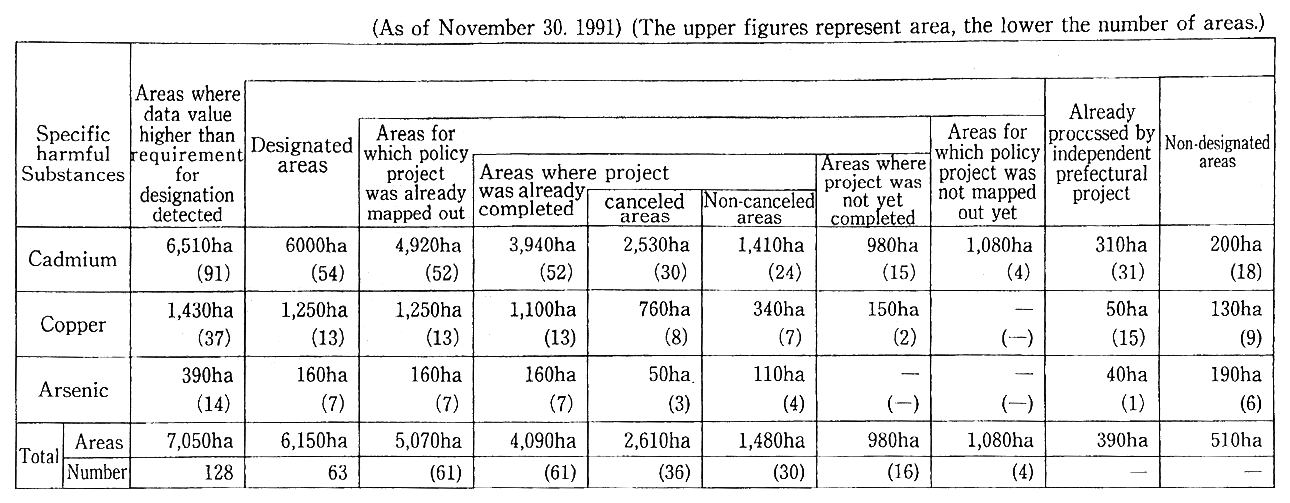
Remarks:1. Surveyed by the Environment Agency
2. The "areas with detection of values exceeding standard values" are based on the findings of the elaborate surveys conducted before 1991.
3. Addition of the figures in each column for area and the number of areas does not coincide withthose in the column for the totals, because pollution was overlapped. Addition of the numbers of areas in each row does not coincide with the totals and the numbers of "areas with detection of values exceeding standard values," because of the existence of areas separately designated and partially taken off.
4. "Projects completed in areas with plans for measures formulated" and "areas with completion ofprefecture's own projects, etc." include the area of land turned to other uses.
5. "Projects completed in areas with plans for measures formulated" represent areas where surfaceconstruction in projects for measures with which the State is associated is completed.
(4) Mine Pollution Prevention Measures
To cope with mine pollution, measures are taken under the Mine Safety Law and the special Law for Mining, Pollution Control in Metal Industries, Etc. The following measures were taken in fiscal 1991.
(A) Promotion of construction work for the prevention of mine pollution associated with shutdown or abandoned mines using a system of financial assistance
(B) Loan projects and technology development by the Metal Industry Corporation for prevention of mine pollution and guidance and support to local governments.
8-4 Pesticide Pollution --Present State and Measures
8-4-1 Present State of Pesticide Pollution
In conjunction with increases in the use of pesticides in the postwar years, the contamination of food and the environment by BHC, DDT, dieldrin, organic mercury and other chemicals posed grave social issues. Controls on the use of pesticides were strengthened and less toxic pesticides developed. As the Pesticide Control Law has been revised and other measures taken, the problems posed by such highly toxic and residual pesticides have decreased. However, biologically active pollut-ants are discharged into the environment when pesticides are used, so that there is the need to properly assess the safety aspects and control the use in order to prevent pesticides from producing adverse impacts on the human body and the environment.
8-4-2 Measures for Prevention of Pesticide Pollution
(1) Control Measures
Under the Pesticide Control Law, pesticides for sale in Japan cannot be registered until their toxicity, residual nature and other factors are inspected. The criteria for suspending registration are (1) those residual in crops, (2) those residual in the soil, (3) those toxic to marine fauna and flora and (4) those associated with water pollution. As of end of December 1991, criteria associated with pesticides residuals in crops were set for 254 pesticides.
Even registered pesticides are designated and their use is controlled under an administrative ordinance when there is a danger that man and cattle may be damaged in light of their residual nature, depending on the methods to use them. (Table 8-4-1)
Table 8-4-1 Agricultural Chemicals Banned in Terms of Environmental Pollution Prevention
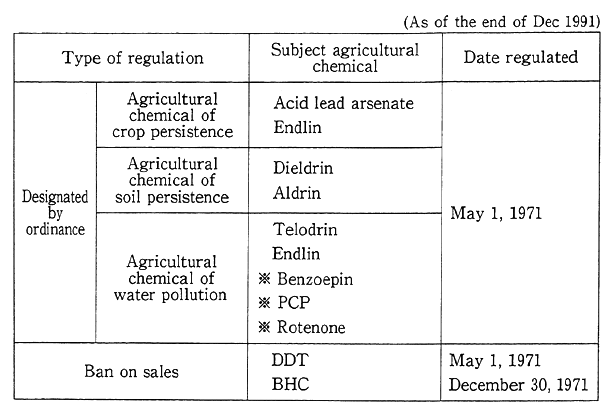
Remarks:1. Surveyed by the Environment Agency
2. Agricultural chemical registered at present
As regards the agricultural chemicals used on golf links, a provi-sional guideline for guidance on the prevention of water pollution was formulated by the Environment Agency (May 1990), and the provisional target for the quality of service water were set by the Ministry of Health and Welfare (May 1990). Moreover in July 1991, target and guideline values were added, bringing the number of target agricultural chemicals to 30.
(2) Surveys and Researches
The following are under way for the prevention of pesticide pollution:
* Surveys on measures against residual pesticides, and fact-finding Surveys on pesticides residual in the environment
* Surveys and researches on the dynamics of agricultural chemicals impurities in the environment, the establishment of methods to assess the impacts of agricultural chemicals on ecosystems, methods to assess the safety of microbial pesticides, and the dynamics of agricultural chemicals in the atmosphere
Chapter9. Promotion of Environmental Health Measures
9-1 Compensation and Prevention of Pollution-Related Health Damage
9-1-1 System of Compensation and Prevention of Pollution-Related Health Damage
The Pollution-related Health Damage Compensation Law was enacted in 1973 in order to work for prompt and fair protection of the sufferers of pollution-related health damage. This law has played a major role in protection of sufferers.
This system is based on liability according to the Civil Code, therefore, the are compensated by the expense of those who discharged pollutants which caused the health damage.
Designated diseases under this system are classified into the following two categories: one is composed of diseases, such as bronchial asthma, which are not specifically associated with causative pollutants (areas where the air pollution is significant and where the incidence of bronchial asthma and other diseases is high due to its impacts are designated as Class I areas), and the other is composed of diseases, such as Minamamata Disease, Itai-Itai Disease and chronic arsenic poisoning, which have a particular connection to causative pollutants (areas where the environmental pollution is significant and where the incidence of the specific diseases is high due to its impacts are designated as Class II areas).
Of these two areas, the Class I areas were reviewed considering changes in the state of air pollution. The Central Council for Environ-mental Pollution Control submitted a report entitled "How Class I areas under the Pollution-Related Health Damage Compensation Law should be addressed" in October 1986. Based on this report ,the following amendments were made and have been enforced since March 1988, namely (1) cancellation of the designation of Class I areas, (2) continuity of compensation to those who are already certified as sufferers, (3) implementation of programs for the prevention of air pollution-related health damage and (4) change of the name of the law to the "Law Concerning Compensation and Prevention of Pollution-Related Health Damage" (hereinafter referred to as the "Compensation Law").
Under the present state of air pollution, the amendments of the system, which are based on the scientific evaluation that it can no longer be regarded that air pollution is the main factor for asthma, are still rational. The Environment Agency will further endeavor to protect certified patients and to implement the programs for the prevention of health damage.
9-1-2 Diseases by Air Pollution
(1) Compensation to Certified Sufferers
The number of certified sufferers as of the end of December 1991 was 91,715. As the designation of Class I areas was canceled on March 1988, no new sufferers have been certified (Table 9-1-1). For the suf-ferers who have already been certified, the payment of benefits and allowances are continued as before under the Compensation Law. And the renewal of certification has also been conducted as before. In order to improve the health and welfare of the certified the sufferers, the health care projects are implemented.
80% of the compensation fund comes from smoke-emitting facil-ities and the remaining 20% comes from automobiles.
In order to deal with requests for a review of the decision in regard to certification or the payment of compensation, there is the Pollution-Related Health Damage Compensation Grievance Board.
The requests for review in association with Category 1 areas are as follows:
(As of the end of December 1991)
Requests for review 182 cases
Revoked 18 cases
Rejected 14 cases
Dismissed 110 cases
Withdrawn 30 cases
(2) Implementation of health Damage Prevention Project
With the enforcement of amended law in March 1988, programs for the prevention of air pollution-related health damage (hereinafter referred to as the "health damage prevention projects") have been implemented. The details of the project are shown in Fig. 9-1-1.
Financial sources for this project utilize working profit of the fund established in the Pollution-Related Health Damage Compensation and Prevention Association. The total amount of the fund is set at ¥50 billion. The fund will be met by contributions from those who are directly responsible for air pollution and those whose business perfor-mance is associated with air pollution, in addition to contribution from the State (¥1,033 million in fiscal 1991). The fund will be developed over a period of seven to eight years, while the fund for projects in each fiscal year is covered by these contributions.
Table 9-1-1 Designated Areas, Number of Certified People, Etc., under the "Law Concerning Compensation for Pollution-related Health Damage and Other Measures".
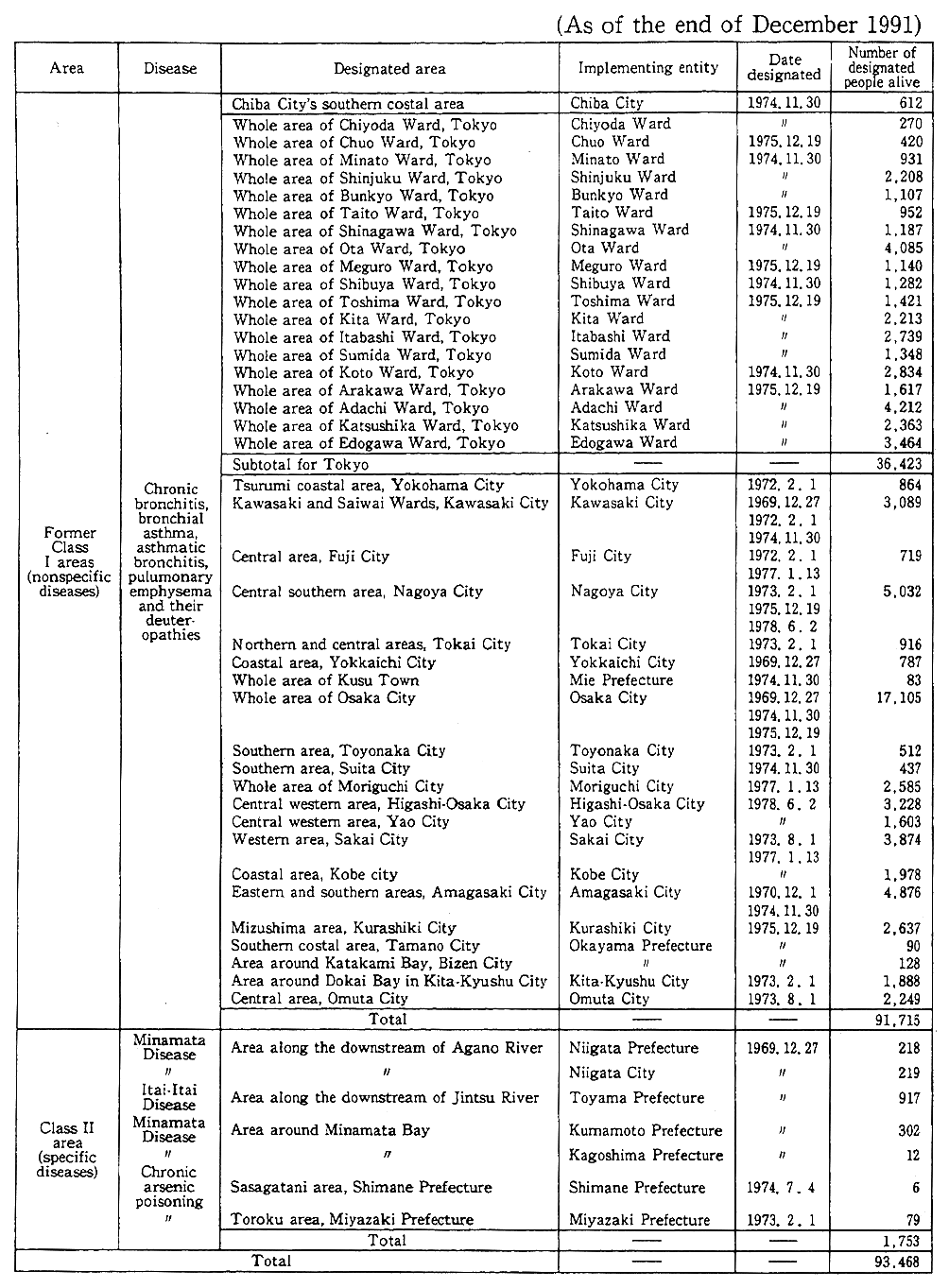
Remarks:1. Surveyed by the Environment Agency.
2. The indication of designated areas are all according to the administra-tive demarcation in force at the time of designation.
Fig. 9-1-1 Outline of health Damage Prevention Projects
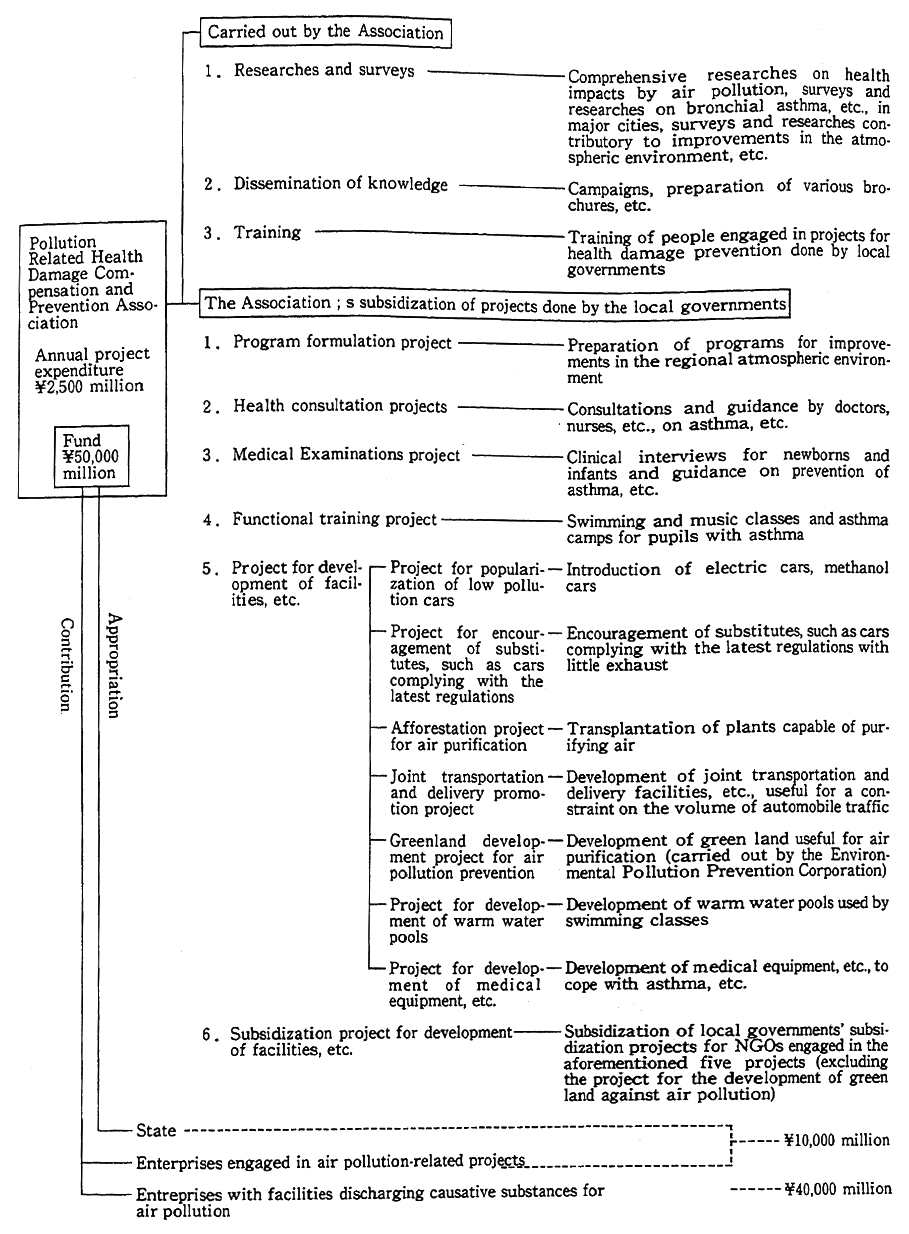
9-1-3 Minamata Disease
(1) Historical Developments
Minamata Disease was detected in areas along Minamata Bay, Kumamoto Prefecture, in 1956, and in the basin of the Agano River in Niigata Prefecture in 1965 as the Second Minamata Disease. In 1968, the government established a consensus view that the disease was caused by the consumption of fish and shellfish in which methylmercury com-pound, discharged from the facilities of Chisso Co., Ltd. and Showa Denko Co., Ltd. respectively, was accumulated. As regards the health damage caused by Minamata Disease, relief measures have been taken since 1969 under the Law Concerning Special Measures for Relief of Pollution-Related Health Damage (hereinafter referred to as "Relief Law") and since 1974 under the Pollution-Related Health Law.
In the meantime, the judgment of the first suit of Minamata Disease in Niigata was handed down in September 1971 and that of the first suit on Minamata Disease in Kumamoto in March 1973. In these judgments, the responsibility of Showa Denko Co., Ltd. and Chisso Co., Ltd. to compensate for damages were established. Based on these judgments, agreements on compensation were concluded between suf-fers' organizations and Showa Denko Co., Ltd. in June 1973 and between them and Chisso Co., Ltd. in July 1973. Thereafter the suffers certified under the Relief Law or the Compensation Law have been able to receive compensation directly from these companies.
Subsequent developments are as follows:
(A) In order to promote the certification process of the disease, the Cabinet members related to Minamata Disease reached an agreement on the "Promotion of Minamata Disease Measures" in 1977.
In response to this agreement, a notice "On Criteria for Differen-tiation of Acquired Minamata Disease" was issued in the name of the Director of the Environmental Health Department, Environment Agency (July 1977), and a notice "On the Promotion of Administrative Work for Certification of Minamata Disease" was issued in the name of the Administrative Vice Minister of the Environment Agency (July 1978).
In Kumamoto Prefecture, also, efforts were made for the quick reduction of the number of applicants who had yet to be judged about certification, such as by the establishment of a system for the medical examination of 150 people and the judgment of 120 people per month in October 1977 (In August 1986, this system was shifted to a new one for the medical examination of 250 people and the judgment of 200 people).
(B) In February 1979, furthermore, the Law Concerning Provisional Measures for the Promotion of Administrative Work on Certification of Minamata Disease was enacted, thus enabling the State, also, to do administrative work for certification.
(2) Present Situation
a. Certification of Minamata Disease
The Certification of sufferers of Minamata Disease in areas along Minamata Bay as of the end of December 1991 is as follows:
Kumamoto Kagoshima
Prefecture Prefecture
The number of living certified suggerers 917 302
The total number of certified sufferers under the Relief Law or the Compensation Law 1,723 481
The number of Certified sufferers before the enactment of the Relief Law(*) 44 1
The number of those who were waiting for certification 2,439 292
Note : (*)Those who had not been certified because of their death before the enactment of the Relief Law.
The certification of sufferers in the basin of the Agano River (Niigata Minamata Disease) as of the end of December 1991 is as follows:
Niigata Prefecture
The number of living certified sufferers 437
The number of certified suffers under the Relief the Relief Law or the Compensation Law 685
The number of certified sufferers before the enactment of the Relief Law 5
The number of those who were waiting for certification 13
It is necessary for Kumamoto and Kagoshima Prefecture to make efforts to speed up certification procedure. In addition to maintain existing system for health examination and screening, it is important to develop a system for those who have not taken health examination because, for example, they live in other prefectures at present, For applicants who live in other prefectures, examination facilities have been established in Nagoya, Osaka and Tokyo, which are outside designated areas.
The official certification of sufferers with Minamata Disease has been nade on the basin of medical judgments, and the appropriateness of the criteria for judgment on whether persons suffered from this disease was reconfirmed by a meeting of medical specialists on Minamata Disease in October 1985. Also in the recommendation made by the Central Council for Environmental Pollution Control in November 1991 ("On the Ideal for Measures to Cope with Minamata Disease"), no findings came out which would make it necessary to altcj the criteria.
b. Medical Treatment Research Program and Special Medical Care Program
The Medical Treatment Research Program has been carried out since fiscal 1974 and a Special Medical Care Program since 1986.
The Medical Treatment Research Program:
which was designed to subsidize the share in the medical care cost, etc., paid by applicants whose examination and judgment drags on over a long time for certification thereby observing and understanding the changes in their conditions.
The Special Medical Care Program:
which was designed to subsidize the share in the medical care cost paid by people, and to contribute to identification of the causative factors and work for ease of health concerns of the people who are found not to be suffering from Minamata Disease but have certain neurological symptoms the causative factors of which cannot be identified. The ptogram was expanded in fiscal 1991, and has been adapted to persons whose applications had been dismissed before May 1986, and who meet the aforementioned condition.
c. Studies on Comprehensive Measures
Efforts have been made for the fair relief of sufferers from Minainata Disease under the Compensation Law. There remain, how-ever, health problems for local residents, posing serious social issues.
The Environment Agency had requested advice from the Central Council for Environmental Pollution Control on comprehensive mea-sures to cope with those problems. In November 1991, the council came out with the recommendation entitled "On Future Measures to Cope with Minamata Disease". In the recommendation, it is pointed out that there is a need to carry out a health care project, including mass health screenings, for persons who have possibly been exposed to methyl mercury compound and also a fully subsidized medical care project for medical care and recupreration for persons who have sensory impair-ment in the extremities. In response to this recommendation, the Environment Agency embarked upon administrative work for the imple-mentation of comprehensive measures.
d. Requests for Reviews of Administrative Dismissal of Applications for Certification of Minamata Disease
The requests for reviews of administrative dismissal of applica-tions for certification with Minamata Disease as of the end of December 1991. are as follows:
under the under the
Relief Law Compensation Law
Requests for reviews of administrative dismissal 626 cases 644 cases
Revocation decided 12 5
Rejected 2 2
Dismissed 362 208
Withdrawn 35 65
e. Minamata Disease-Related Lawsuits
The lawsuits filed by organizations of applicants for official certification patients with Minamata Disease are pending at nine courts against the State, Kumamoto prefecture and the responsible companies.
Since September 1990, a reconciliation has been recommended by five courts which are involved in the lawsuits in which damages are demanded in conjunction with Minamata Disease around Minamata Bay. The State has replied to these recommendation that it is difficult to comply with them.
In the lawsuit in which the State and Kumamoto Prefecture are defendants and the damage compensation is demanded for inaction and illegality on the part of the Governor of Kumamoto Prefecture in relation to administrative work on the official certification as Minamata Disease patients, the Supreme Court dismissed the original decision which recognized the demands made by the plaintiffs at the first trial and referred the case back to the Fukuoka High Court in April 1991.
As regards the lawsuit at the Tokyo District Court in which the State, Kumamoto Prefecture and Chisso Co., Ltd. were requested to pay damages, the court ruled that the State and Kumamoto Prefecture were cleared of any liability under the State Liabillity Law. In the judgment, it was pointed out that even in cases where the plaintiffs cannot be medically diagnosed as suffering from Minamata Disease, if there is a "some possibility" of their suffering from Minamata Disease, it may be considered apporopriate to recognize the responsibility for paying damages of Chisso Co.., Ltd., and then to reflect that in computation of the amounts of damages (solatia). The plaintiffs and Chisso Co., Ltd., filed complaints about the decision and appealed to the Tokyo High Court, where this case remains pending.
As regards the lawsuit which was in dispute at the Niigata District Court against Showa Denko Co., Ltd. in demand for damage compensation, the court recognized Showa Denko's responsibility for the compensation of damages and declared that the State did not have any liability under the State Liability Law. In this decision, the court admitted that there existed Minamata Disease of the sort in which main neurologic symptoms wereconfined to sensory impairment, and as regards the plaintiffs who had sensory disorders in the extremities, the court conjectured that those disorders stemmed from Minamata Disease in cases where facts about conjectured that those disorders stemmed from Minamata Disease in cases where facts about exposure to methyl mercury compound and its accumulation was very likely and the possi-bility of the sensory impairment arising from other diseases was highly unlikely. Unhappy with this decision, the plaintiggs and Showa Denko Co., Ltd., appealed to the Tokyo High Court, where the case remains pending.
f. Financial Support to Chisso Co., Ltd.
To the people who are certified as the sufferers of Minamata Disease, Chisso Co., Ltd. the polluter, has directly compensated for their health damage. Adhering to the Polluter Pays Principle, giving consider-ation to the necessity to ensure the continuation of the compensation, the government has requested related banking institutions for financial and other support in accordance with the agreement reached by the Cabinet in June 1978 "On Measures to Cope With Minamata Disease", on the one hand, and a system is in effect whereby the funds procured by Kumamoto Prefecture Government's bond may be put on loan to Chisso Co., Ltd. on the other.
This system had been expired by compensation payment in fiscal 1990, but it was decided that this system would be continued in force for yet another three years from 1991.
g. The National Institute for Minamata Disease
The National Institute for Minamata Disease, established in October 1978 as the nation's sole comprehensive medical research insti-tute on Minamata Disease, is engaged in clinical research, basic research and epidemiological surveys and research for a clarification of the clinical manifestation of Minamata Disease and establishment of therapeutic methodologies. In September 1986, this Institute was designated as a collaborative study center by the World Health Organi-zation (WHO).
9-1-4 Itai-Itai Disease
Itai-Itai Disease was found in the basin of Jintu River in Toyama Prefecture. It was reported to a medical society as a strange disease in October 1955. In 1968, the Ministry of Health and Welfare made an administrative statement that Itai-Itai Disease was initiated by renal dysfunction that was caused by chronic cadmium poisoning, which was followed by osteomalacia. It delivered that pregnancy, breast feeding, changes of internal secretion, aging and shortage of calcium and so on helped osteomalacia develop into Itai-Itai Disease. It stated that the only source cadmium identified was the waste water of Kamioka Mining Plant of Mitsui Mining and Smelting Co., Ltd.
The official certification of sufferers of Itai-Itai Disease as of the end of December 1991 is as follows:
Toyama Prefecture
The number of those certified living sufferers 12
The total number of certified as sufferers under 130
the Relief Law or the Compensation Law
(2) Present State
The health examination continues of 13 people in its designated areas in Toyama Prefecture who require long-term observation in order to observe their progress (as of the end of December 1991).
There were 7 cases in which requests for review of the administra-tive decision under the Compensation Law had been filed with the Pollution-Related Health Damage Compensation Grievance Board as of the end of December 1991.
9-1-5 Chronic Arsenic Poisoning
The outbreak of chronic arsenic poisoning in the Toroku area of Miyazaki Prefecture was reported on the basis of a survey conducted by Miyazaki Prefecture in July 1972. The outbreak of chronic arsenic poisoning in the Sasagatani area of Shimane Prefecture was reported on the basis of f survey conducted by Shimane Prefecture. The official certification of sufferers as the end of December 1991 in as followed:
Miyazaki Shimane
Prefecture Prefecture
(Toroku) (Sasagatani)
The number of these certified living sufferers 79 6
The total number of certified sufferers 142 21
under the Relief Law or Compensation Law
The requests for a review of the administrative decision under the Compensation Law had been filed with the Pollution Related Health Damage Compensation Grievance Board as of the end of December 1991 are as follows:
Requests for review 67 cases
Revocatdon decided 7 cases
Dismissed 48 cases
Withdrawn 12 cases
9-2 Surveys and Research on Environmental Health
9-2-1 Adverse health effects of Air Pollution
The following surveys and research are under way:
(A) Surveys for the establishment of methodology to periodically and continuously monitor relations between air pollution and its health impacts, and to promptly build an environmental health surveillance system for the formulation of necessary measures.
(B) Assessment of relations between localized air pollution and impacts on health as is the case with roadside areas along some arterial roads
9-2-2 Research on the adverse health effects of substances (such as Cadmium)
Following are the surveys and the research that the Environment Agency is conducting;
(A) Health surveys of residents in areas with environmental cadmium
pollution; The surveys that the agency conducted so far found out no Itai-Itai disease patients in any areas other than in the basin of Jintsu River in Toyama Prefecture. Since 1985, the agency has been conducting health surveys of the residents who live in the basin of Jintsu River and had showed some findings at the surveys performed between 1979 and 1984.
(B) Studies of health effects of cadmium
The agency has been conducting researches on the mechanism of Itai-Itai disease and the adverse effects of cadmium on human health. In 1989, it compiled the findings of the study and made the interim report. It continues with the study.
(C) Comprehensive studies on Minamata Disease
Comprehensive studies on the impacts of heavy metals and so forth on human bodies were conducted.
Chapter10. Settlement of Pollution Disputes and Handling of Pollution Offences
10-1 Settlement of Pollution Dispute and Grievances About Pollution
10-1-1 Settlement of Pollution Disputes
(1) Framework of Disposition of Pollution Disputes
It is stipulated in the Law Concerning the Settlement of Pollution Disputes that pollution disputes shall be settled by the Conciliation Committee on Environmental Pollution, Etc., an external body of the Prime Minister's Office; the Prefectural Environmental Pollution Screening Commission established by each prefecture; and so forth. The dispute settlement system is outlined in Fig. 10-1-1.
Fig. 10-1-1 Scheme of Pollution Dispute Processing System
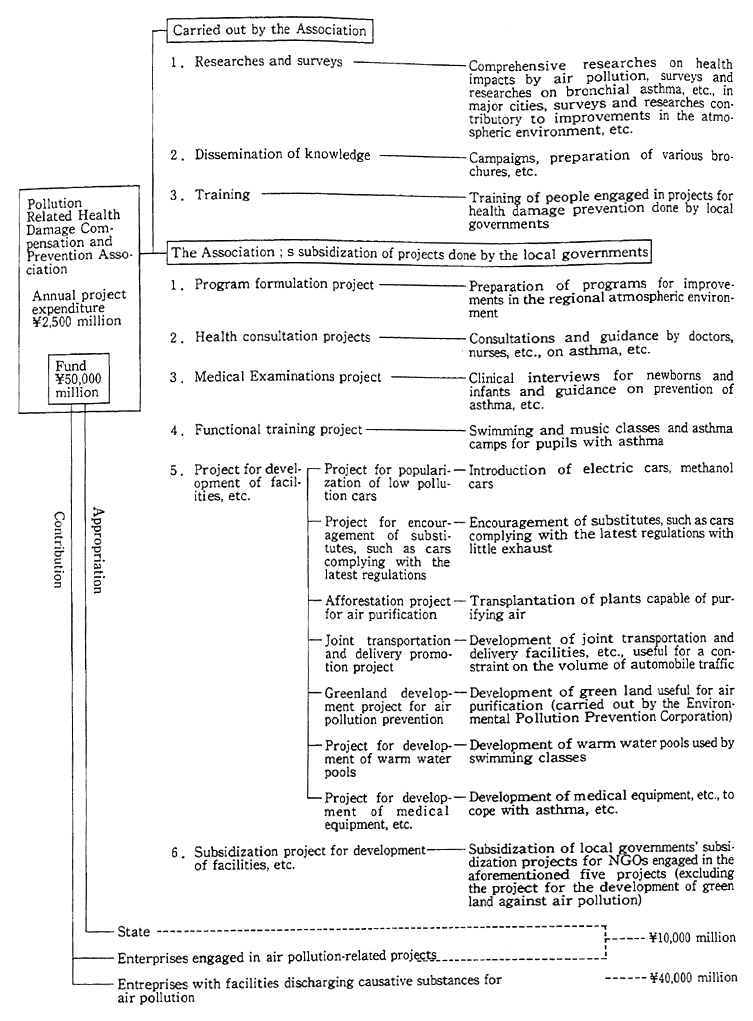
The procedure for the settlement of environmental pollution dis-putes consists of mediation, arbitration, intercession and ruling. The Concili-ation Committee on Environmental Pollution exclusively makes rulings and in so-called serious cases and those cases which require an inter-juris-dictional settlement, and carries out mediation, arbitration and inter-cession. The Prefectural Environmental Pollution Screening Committee makes mediation, arbitration and intercession for all other types of cases.
(2) Settlement of Pollution Disputes
a. Cases Pending at the Conciliation Committee on Environmental Pollution
In Fiscal 1991, the Conciliation Committee on Pollution accepted 12 new cases pending over environmental pollution.. With the additional 12 cases carried over from the preceding year, a total of 24 cases (20 cases for arbitration, one case for a ruling on responsibilities, two cases for a ruling on causes and one case for a recommendation on the fulfillment of obligations) remained pending in 1991. The pending cases are as follows:
A. Cases for Arbitration
1. Cases in which arbitration was requested for the compensation of damages by Minamata Disease along the coast of the Sea of Shiranui 10 cases
2. Cases in which arbitration was requested for a ban on the use of studded tires, etc. 2 cases
3. Case in which arbitration was requested on dam-age caused by pesticides on golf links in Yamana-shi and Shizuoka 1 case
4. Case in which arbitration was requested on dam-age caused by the construction of the trans-Tokyo Bay road. 1 case
5. Case in which arbitration was requested to sus-pend the operation of a nuclear reactor. 1 case
6. Case in which arbitration was requested to pre-vent noise from the Hokuriku Shinkansen Line 1 case
B. Case for Ruling on Responsibilities Case in which a ruling was to be made on respon-sibilities for noise from outdoor heating equip-ment 1 case
C. Cases for Rulings on Causes
1. Case in which a ruling was sought on causes to the noise of public-address systems on a shopping street 1 case
2. Case in which a ruling was sought on causes to vibration from the burying of A sewage pipes 1 case
D. Case for Recommendation on Fulfillment of Obligations Case in which a request was made for the fulfill-ment of the obligations specified in the arbitra-tion on the noise of Osaka International Airport 1 case
Of them, 22 cases, including 18 cases for arbitration, three cases for rulings and one case for a recommendation on obligations, were brought to an end in fiscal 1991, and the remaining two cases were carried over to the succeeding fiscal year.
b. Cases Pending at the Prefectural Environmental Pollution Screening Committee.
Prefectural environmental pollution screening committees accepted 52 cases in environmental pollution disputes in 1991. With 54 cases carried over from the previous year, a total of 106 cases (all of which were cases for arbitration) remained pending in 1991. 31 cases were settled in 1991.
10-1-2 Disposition of Grievances About Environmental Pollution
(1) System for Disposition of Grievances About Environmental Pollution
It is stipulated in the Law Concerning the Settlement of Environ-mental Pollution Disputes that local governments shall cooperate with related administrative institutions in appropriately settling grievances about environmental pollution. For this purpose, it is stipulated that prefectures and municipalities may be able to assign environmental pollution grievance consultants.
(2) Present State of Grievances About Environmental Pollution
Grievances about environment pollution newly filed with local governments across the nation in fiscal 1990 totaled 74,294, and trends in this figure are shown in Fig. 10-1-2. Of the total, there were 49,359 grievances about seven typical kind of environmental pollution (Fig. 10-1-3). In the settlement of grievance about environmental pollution, as seen in Fig. 10-1-4 and 10-1-5, about three-fourths of the complainants were satisfied with the findings.
The filing and disposition of grievances with police about envi-ronmental pollution are indicated in Table 10-1-1 and 10-1-2.
Fig. 10-1-2 Trends in Number of Grievances
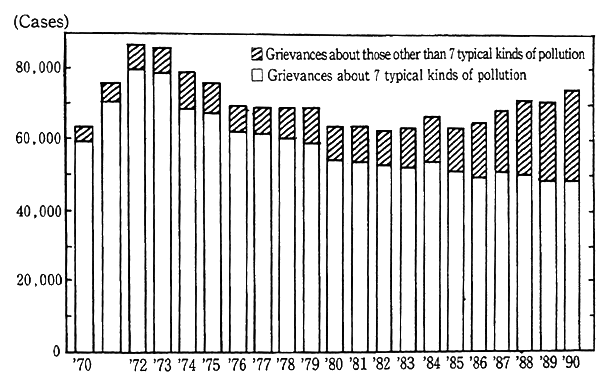
Source : Secretariat, Coordination Committee on Environmental pollution, Etc. "Report on Findings of Survey on Number of Grievances about Environmental pollution in FY1990"
Fig. 10-1-3 Kind-Specific Trends in Number and Component retio of Grive-ances (FY 1979-90)
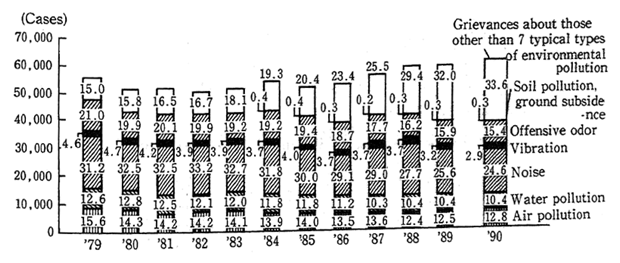
Notes : 1. Secretariat, Coordination Committee on Environmental pollution, Etc.: "Report on Findings of Survey on Number of Grievances about Environ-mental Pollution in FY1990" 2. The values in the figure represent component ratios (%).
Fig. 10-1-4 Rate of Grievances about Environ-mental Pollution by Disposition Period

Fig. 10-1-5 Degrees of Complainants about Results of Disposition of Grievances about Environmental Pollution

Source : Secretariat, Coordination Committee on Environmental pollution, Etc. :"Disposition by Local Government Governments about Environmental Pollution in FY1989"
Table 10-1-1 Polution Complaints Filed with Police (1991)
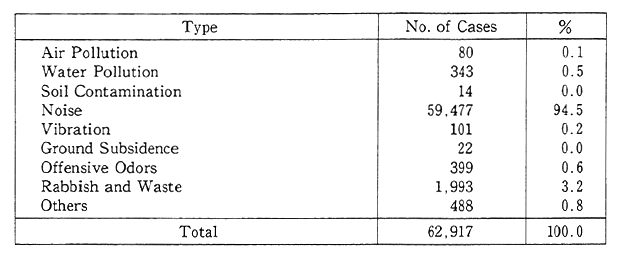
Source : National Police Agency.
Table 10-1-2 Police Response to Pollution Grievances (1991)

Source : National Police Agency.
10-2 Controls on Environmental Pollution Offenses
10-2-1 Control Priorities and Arrests
In police controls, priority is given to the offenses which involve malicious and illegal disposal of industrial wastes and water pollution. Arrests made in connection with environmental pollution offenses in the last five years are shown in Table 10-2-1. The number of arrests, as classified by law and ordinance, is given in Table 10-2-2. The patterns of industrial waste offenses, which account for most of them, the kinds of wastes which are illegally disposed, and the locations are outlined in Table 10-2-3 and Fig. 10-2-1.
Table 10-2-1 Trends in Number of Arrests in Pollution Offenses
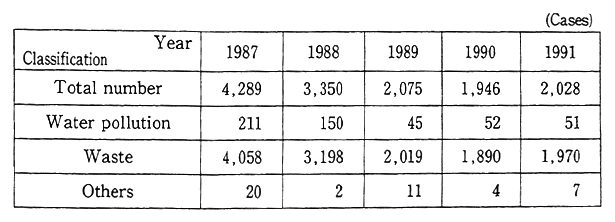
Remarks: Surveyed by the National Police Agency.
Table 10-2-2 Number of Arrests in Pollution Offense by Law (1991)

Remarks: Surveyed by the National Police Agency.
Table 10-2-3 Arrests by Type of Violation in Disposal of Wastes (1991)

Source : National Police Agency' s survey.
Fig. 10-2-1 Illegal Disposition of Industrial Wastes by Kind and by Place
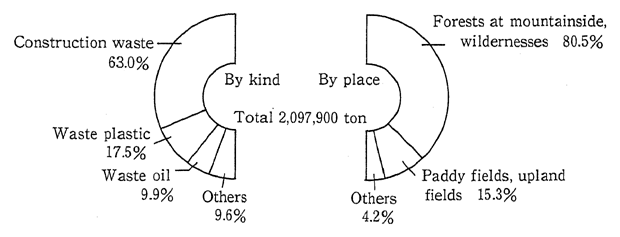
Remarks: Surveyed by the National Police Agency.
10-2-2 Acceptance and Disposition by Prosecutors Offices of Cases in Violation of Environmental Pollution-Related Laws and Ordinances
The acceptance and disposition by prosecutors offices of cases in violation of environmental pollution-related laws and ordinances are shown below (Table 10-2-4, Table 10-2-5 and Table 10-2-6).
Table 10-2-4 Trends in Ordinary Disposition of Violations of Environ-mental Pollution-Related Laws and ordinances and in Number of Persons Processed
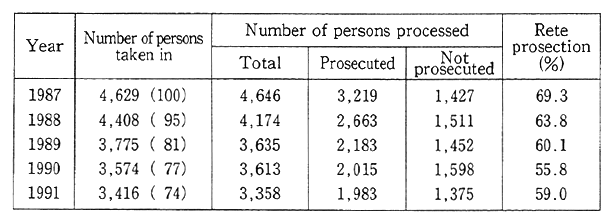
Notes: 1. Surveyed by the National Police Agency
2. The figures in brackets represent indices with 1987 at 100.
3. Rate of prosecution=number of persons
Table 10-2-5 Offense-Specific Numbers of Persons Taken in on Charges of Violating Environmental Pollution-Related Laws and Ordinances
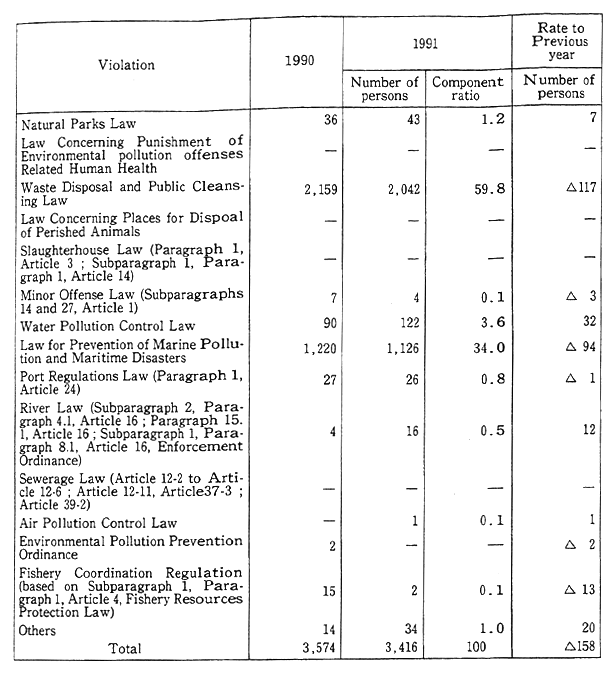
Notes:1. Source: Ministry of Justice
2. ![]() (in case of decrease)
(in case of decrease)
Table 10-2-6 Offense-Specific Number of Persons Processed in Viola-tions of Environmental Pollution Laws and Ordinances
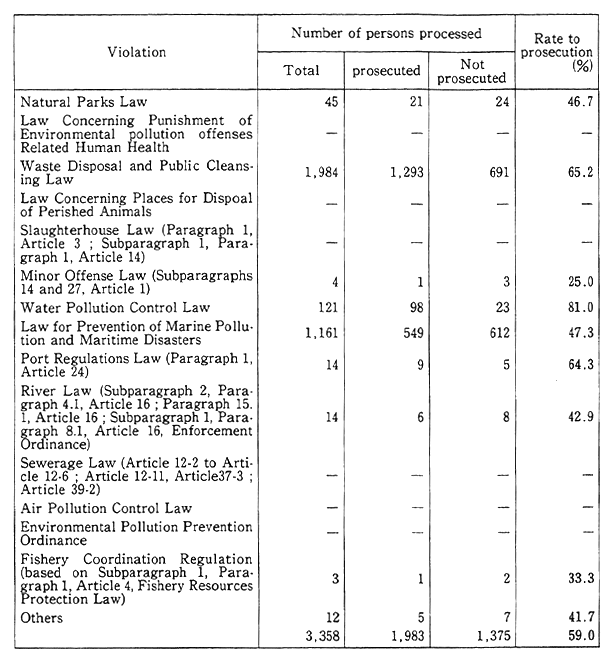
1. Surveyed by the Ministry of Justice
2. Rate of prosecution = number of persons prosecuted/(number of persons prosecuted + number of persons not prosecut-ed)
Chapter11. Conservation of Natural Environment
11-1 Comprehensive Promotion of Measures for Conservation of Natural Environment
11-1-1 the Nation Wide Survey of Nature
In order to accurately understand the present situation of the natural environment which is undergoing a change and foresee its direction, the Nation Wide Survey of Nature is performed in accor-dance with Article 5 of the Nature Conservation Law. Generally known as the National Green Census, this survey is conducted every five years to comprehensively and scientifically survey the conditions of Japan's natural environment. Following the first survey in fiscal 1973, the second in fiscal 1978 and fiscal and the 79 third one from fiscal 1983 to fiscal 1987, the fourth one has been under way since fiscal 1988. The survey is outlined in Fig. 11-1-1.
In fiscal 1991, the following matters were surveyed:
a. A "vegetation survey" with the use of satellite images
b. An "animal distribution survey" designed to understand the distribution of animals in general
c. A "lake and marsh survey" designed to understand the conditions of lakes and marsh and the biota
d. A "marine organism environment survey" designed to understand the present state of tideflats, seaweed beds and coral reefs
e. A "comprehensive ecosystem monitoring survey" designed to cast light on the characteristics of ecosystems, the actual conditions of changes and so forth
Fig. 11-1-1 Keynotes of the 4 th National Survey on Preservation of Natural Environment
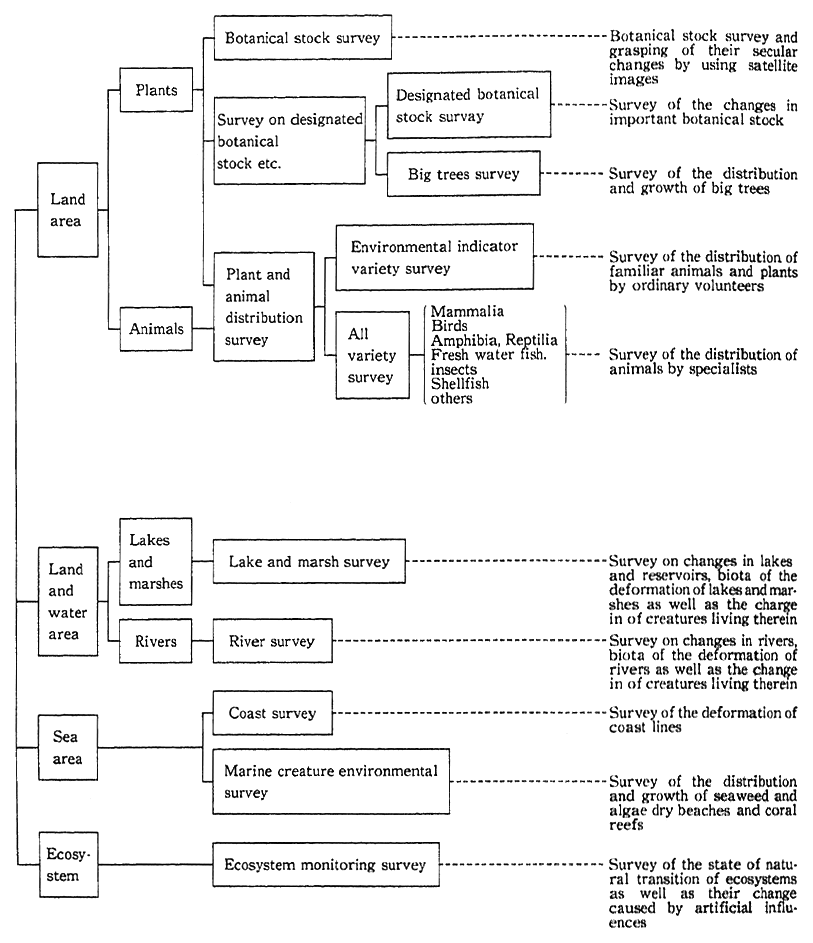
11-1-2 Increasing Awareness of Nature Conservation and Promoting of Nature Education
As increasing the desire for communing with nature among people, it has become more important to promote appropriate utiliza-tion of the natural environment.
In response to this demand, the Environment Agency established the office for Promotion of Communication with Nature in the Nature Conservation Bureau in April 1991, which carried out the following measures in fiscal 1991:
(1) Holding of various events for communication with nature in order to enhance people's understanding, affection and ethical behavior towards nature, the Agency, in cooperation with local governments and non governmental organizations, held the following events
a. In commemoration of Green Day on April 29 (a national holiday), the "Green Day Gathering for Communication with Nature" was held in the Shinjuku-gyoen National Garden in Tokyo and in natural parks throughout the country.
b. During the Campaign for Communication with Nature which starts on July 21 and ends on August 20, nature observations and other various events are held in natural parks. The 33rd Natural Park Festival, the central event of the campaign, was held in the Kusatu area of the Joshinetsu-Kogen National Park.
c. Aimed at enhancing public awareness and health through walking in nature, the National March ensloganed "Let's Walk Nature Trails" takes place along nature trails in 47 prefectures in October.
(2) Training Leaders for Promoting Communication with Nature
In order to prepare volunteers in national parks, the Agency carried out the Park Volunteers Project in the Setonaikai National Park and other two park.
In addition, the Agency held a training for interpretation staffs and orientation seminars for newly-committed volunteer park rangers.
11-1-3 Citizen Participation in Nature Protection
National Trust activities designed to acquire tracts of land whose natural environment is favorable, manage them and work for their conservation with the people's voluntary involvement through fund-raising and other activities are being promoted at many places across the nation, such as the Campaign for the Building of an Okhotsk Village in Koshimizu Town, Hokkaido, and the Citizens' Campaign for Conser-vation of Cape Tenjinzaki. Those activities are quite instrumental in promoting nature conservation activities from within the citizens, and their dissemination and settlement are desirable.
In fiscal 1991, non-profit organization for nature conservation (non-profit organizations whose primary purpose is to purchase and manage tracts of land whose natural environment is favorable) were designated as specified judicial persons for public good promotion, for whom preferential tax measures are available, including credit for contribution loss they have received. A symposium was held at the Ninth National Convention of the National Trust for a further dissemi-nation of information on its activities.
11-2 Conservation of Natural Parks
11-2-1 Conservation of Nature Conservation Areas
In accordance with the provisions of the Nature Conservation Law, it is stipulated that wilderness areas (the areas whose natural environment is maintained in a primeval state without being affected by man's activities) and nature conservation areas (the areas where conser-vation of the natural environment is especially important for natural and social conditions other than the wilderness areas). As of the end of fiscal 1991, five areas were designated as wilderness areas and nine areas as nature conservation areas.
Table 11-2-1 Classified Areas in Natural Conservation Areas etc.
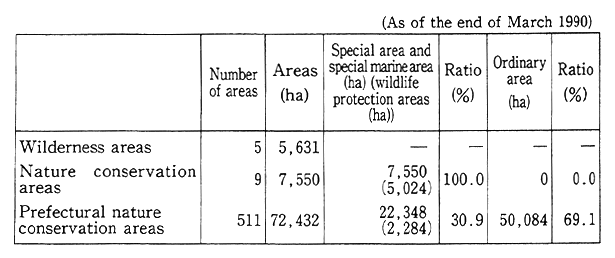
Remarks: Surveyed by the Environment Agency.
It is also stipulated that prefectures may designate as prefectural nature conservation areas those areas where conservation of the natural environment is especially important in accordance with decrees, etc. As of fiscal 1991, 511 areas had been so designated. (Table 11-2-1)
11-2-2 Protection of Nature in Nature Conservation Areas
In light of the importance of nature conservation areas, studies are conducted to contribute to their reasonable conservation. By fiscal 1989, fact-finding studies have been conducted in all areas. In fiscal 1991, specialist studies were made on the formulation of future research and study programs.